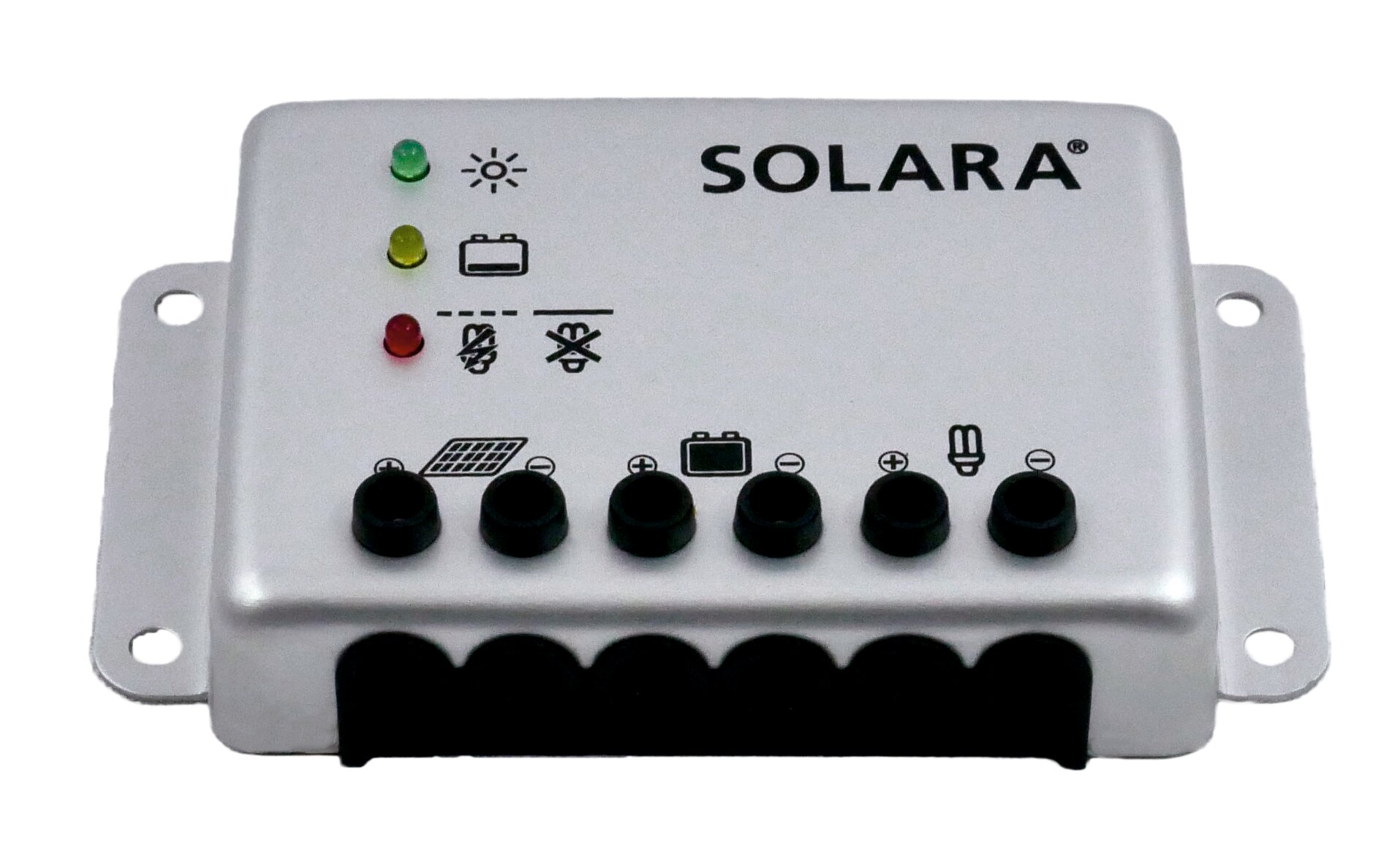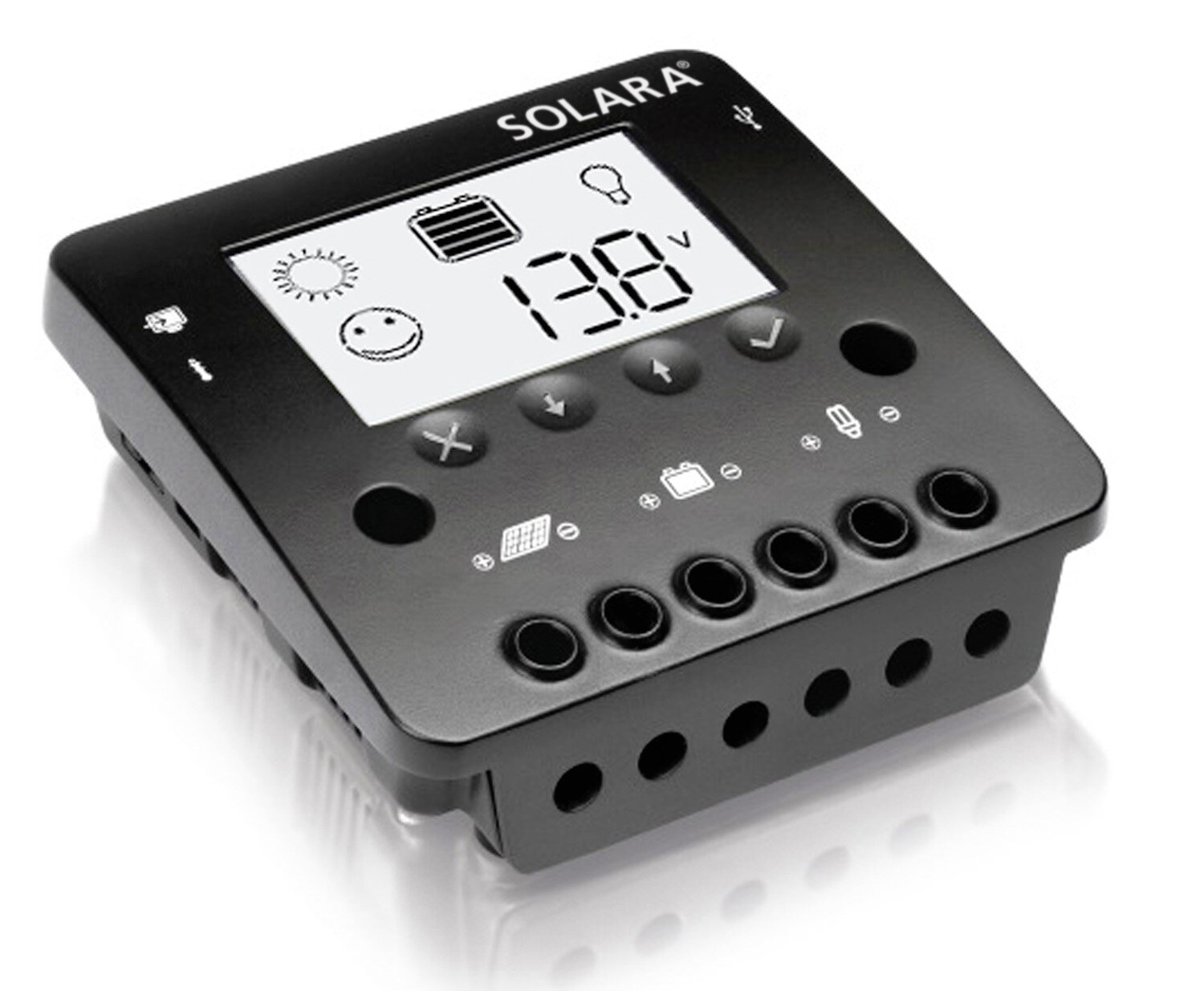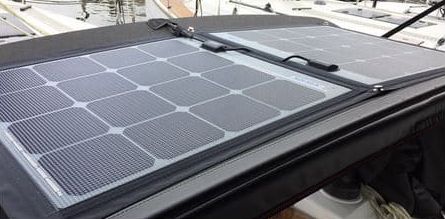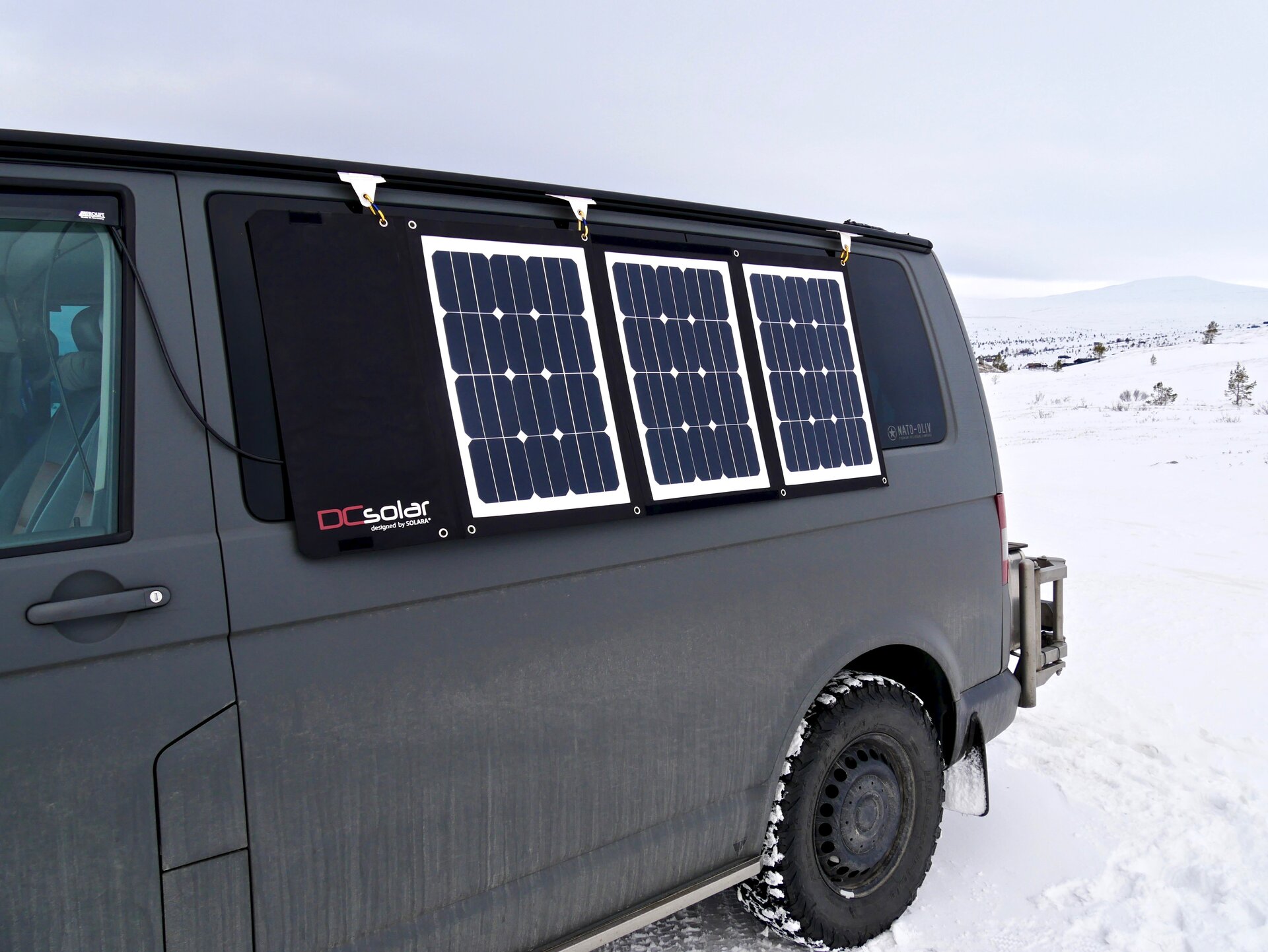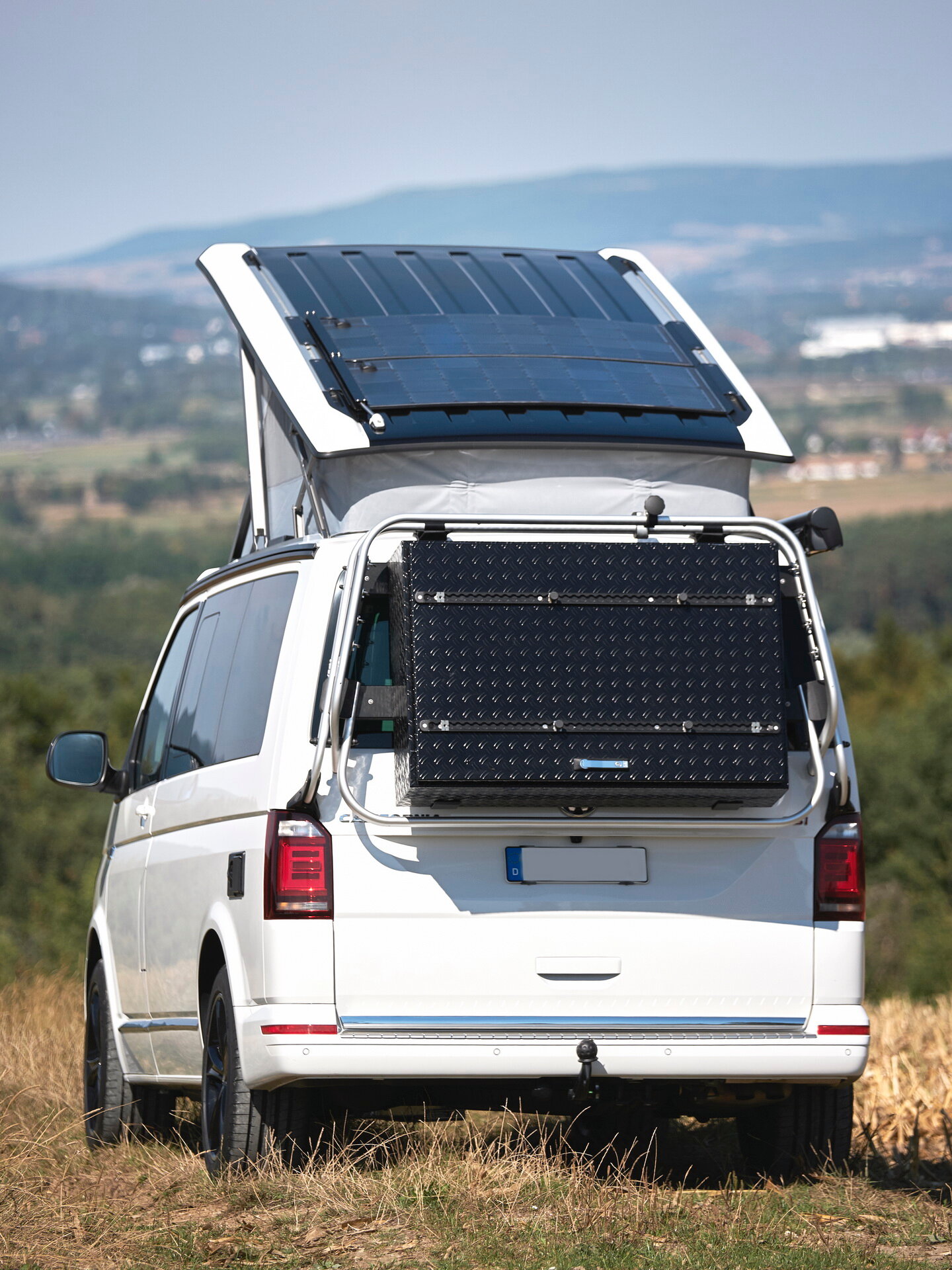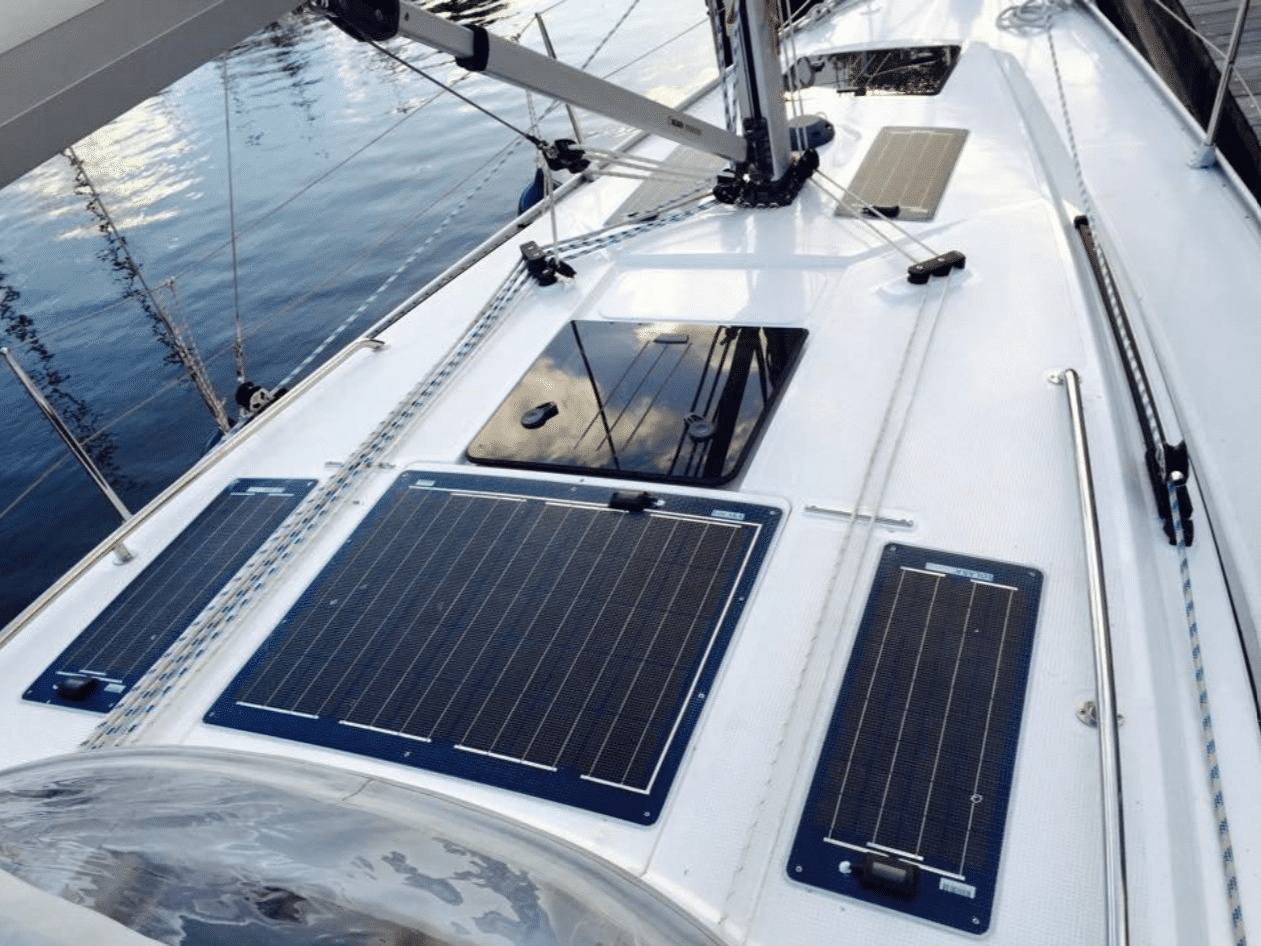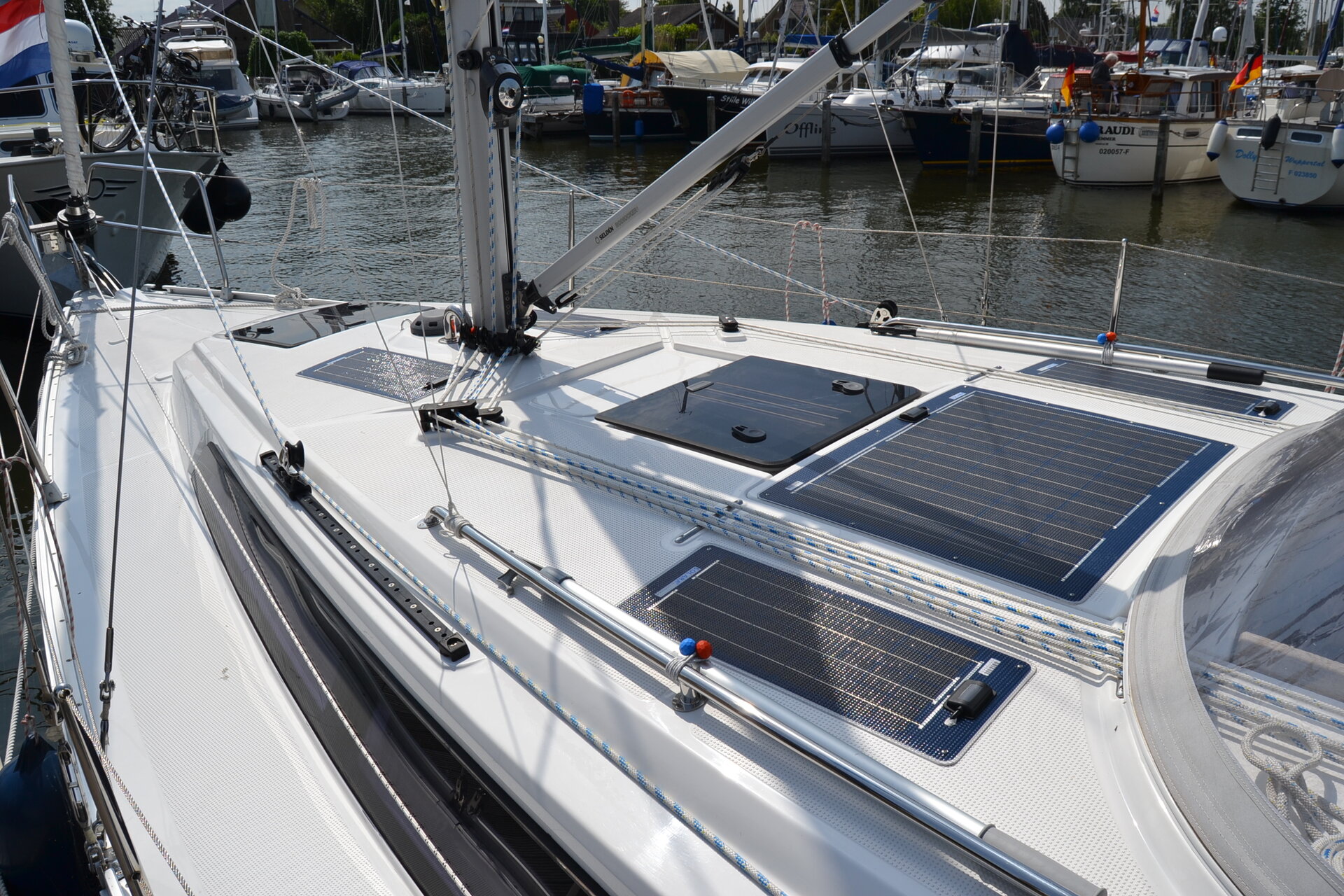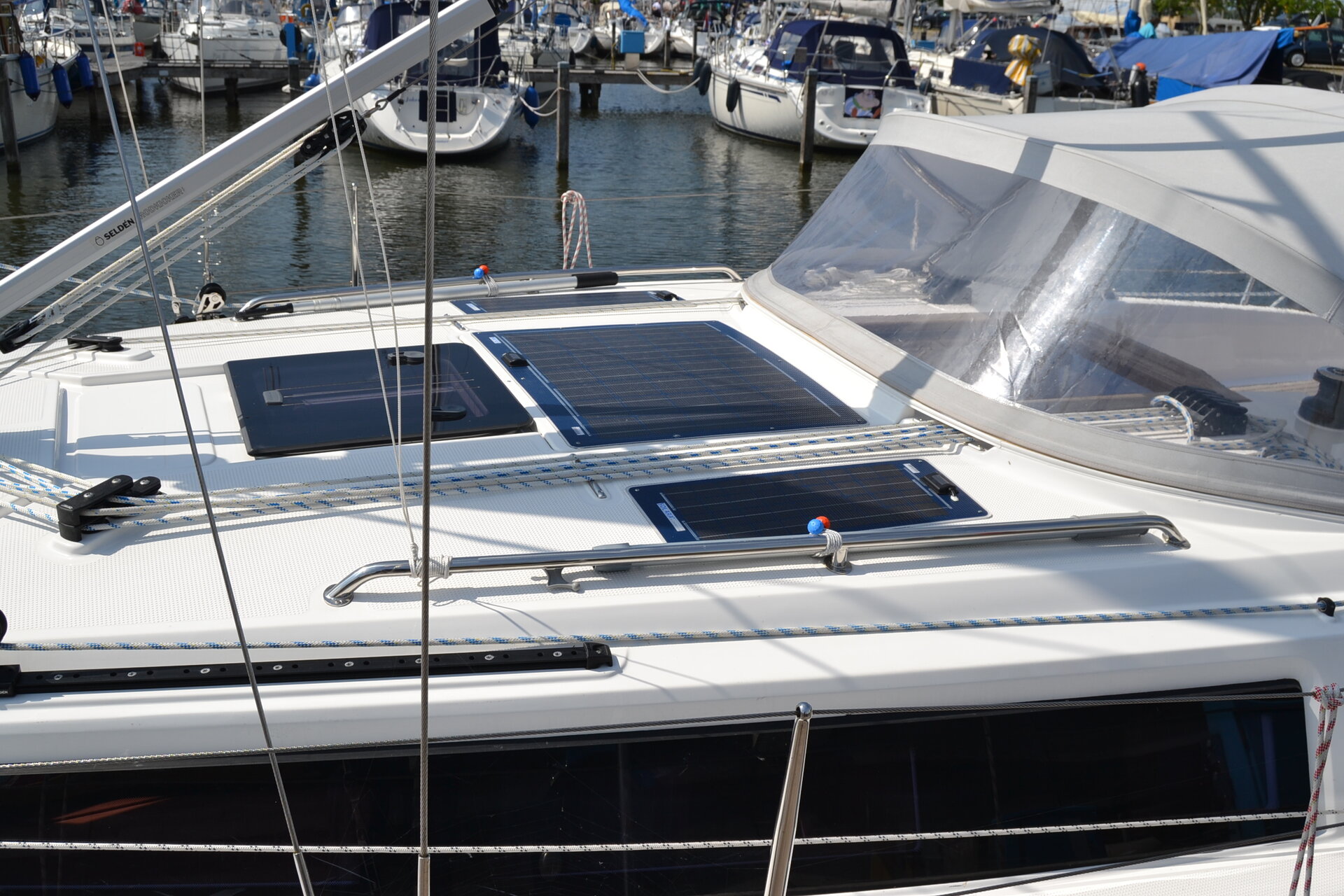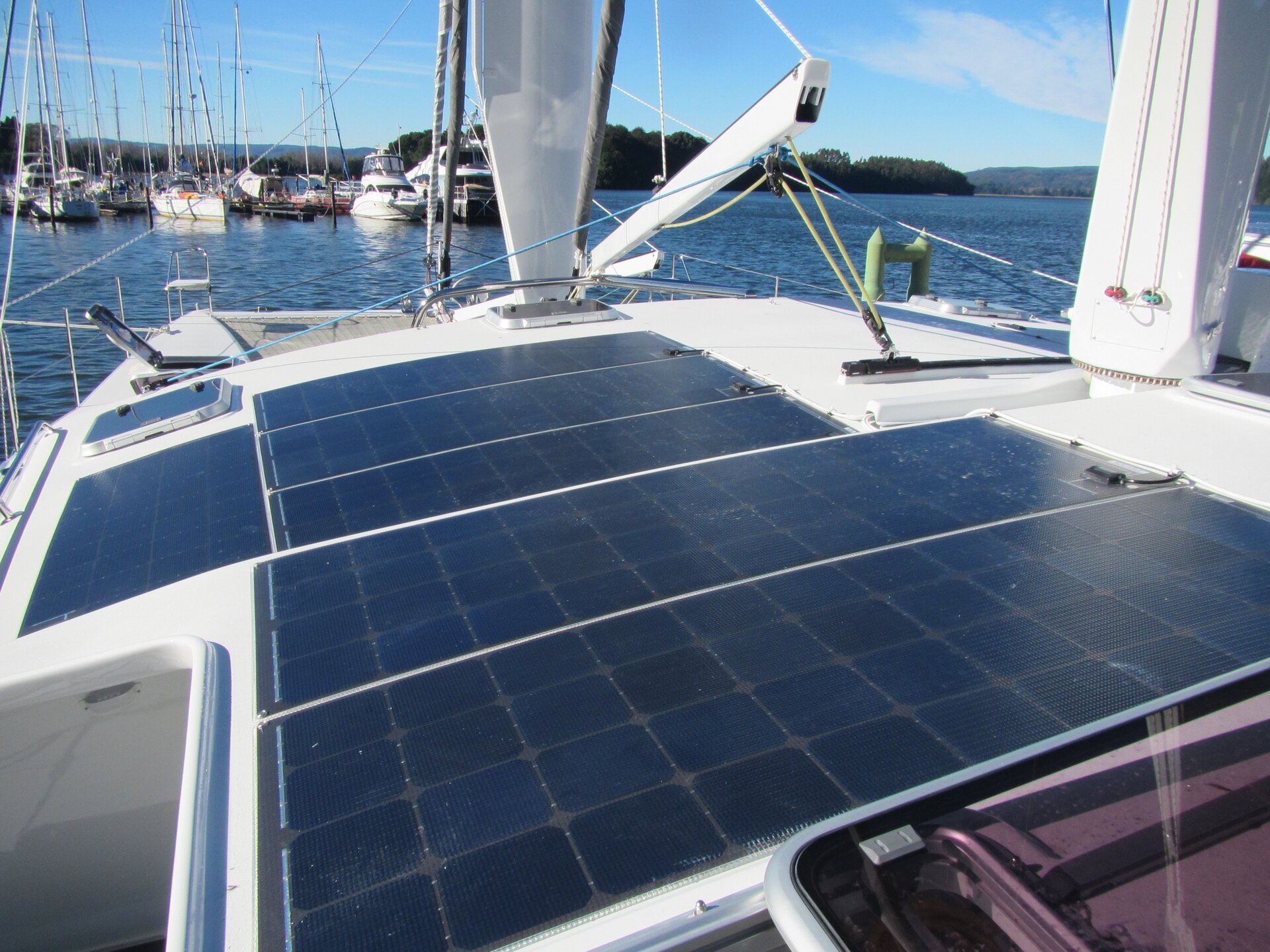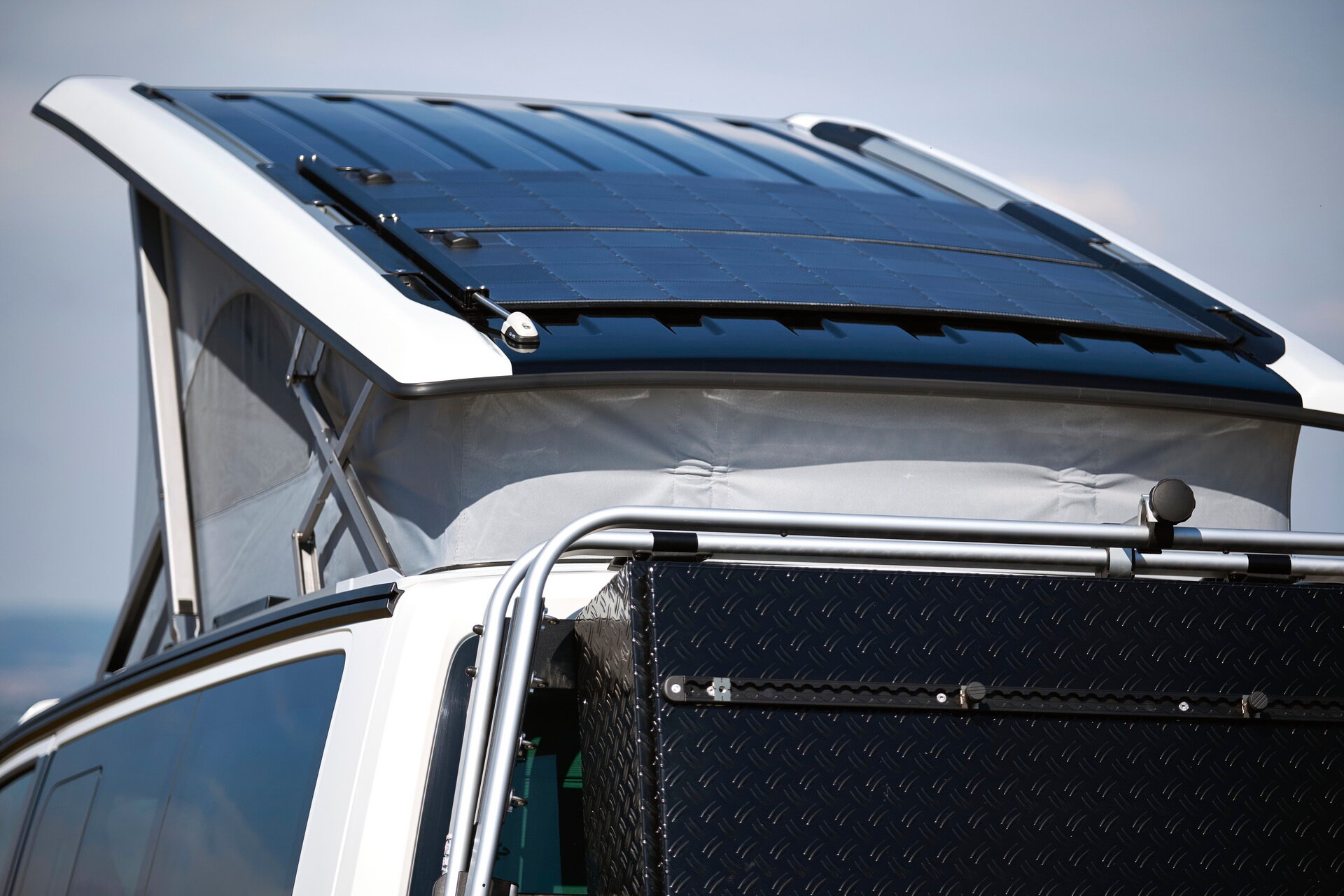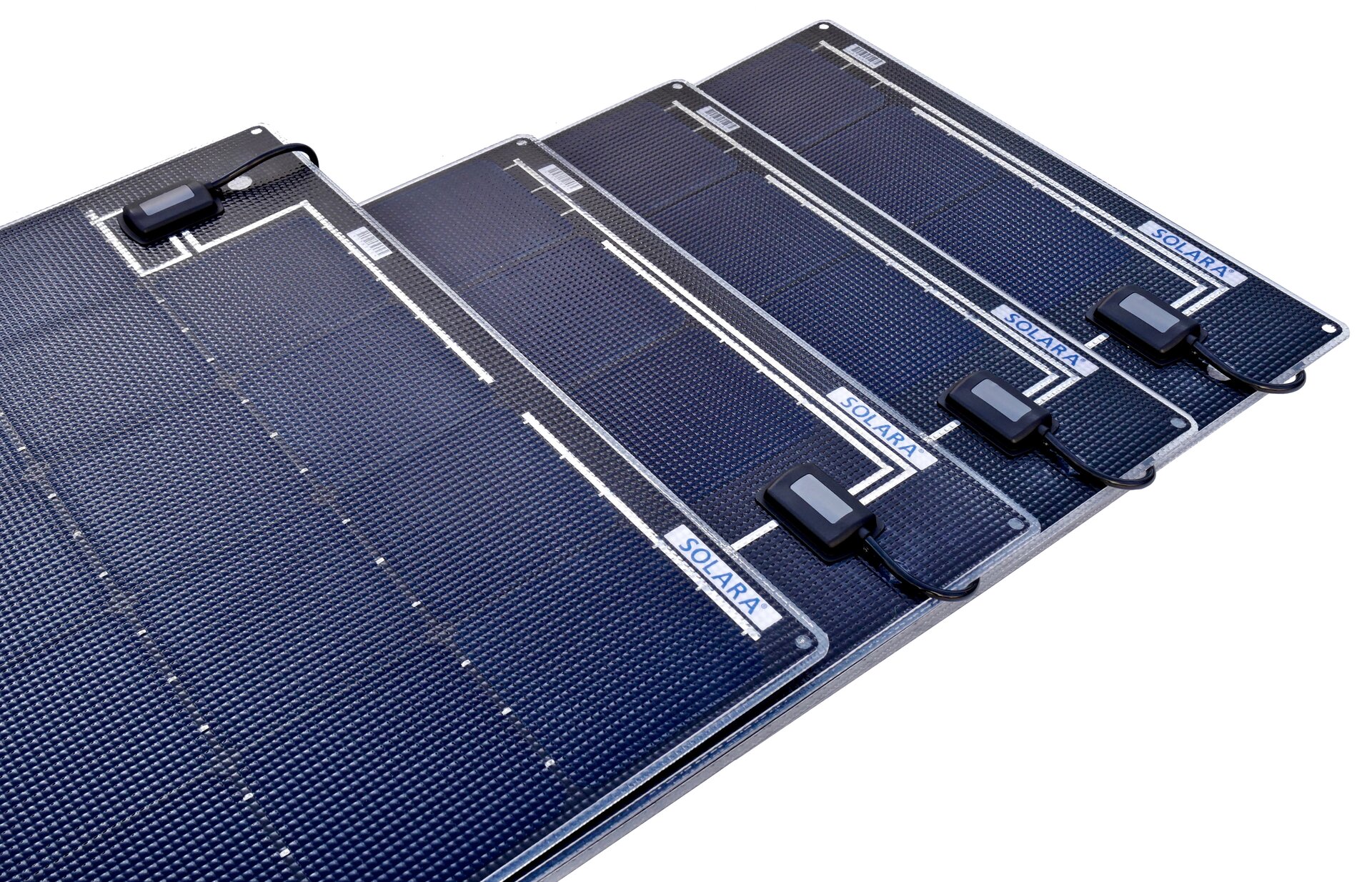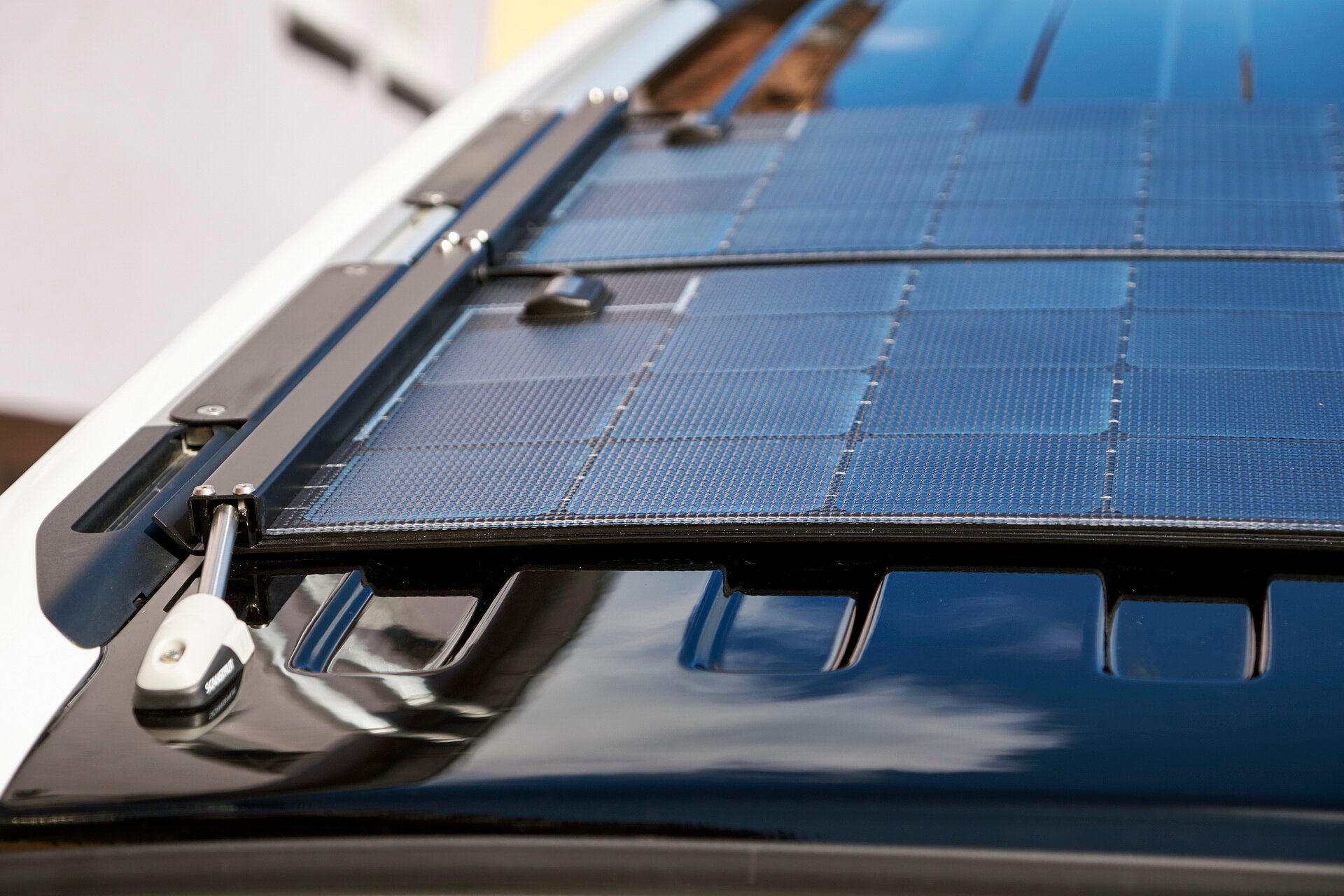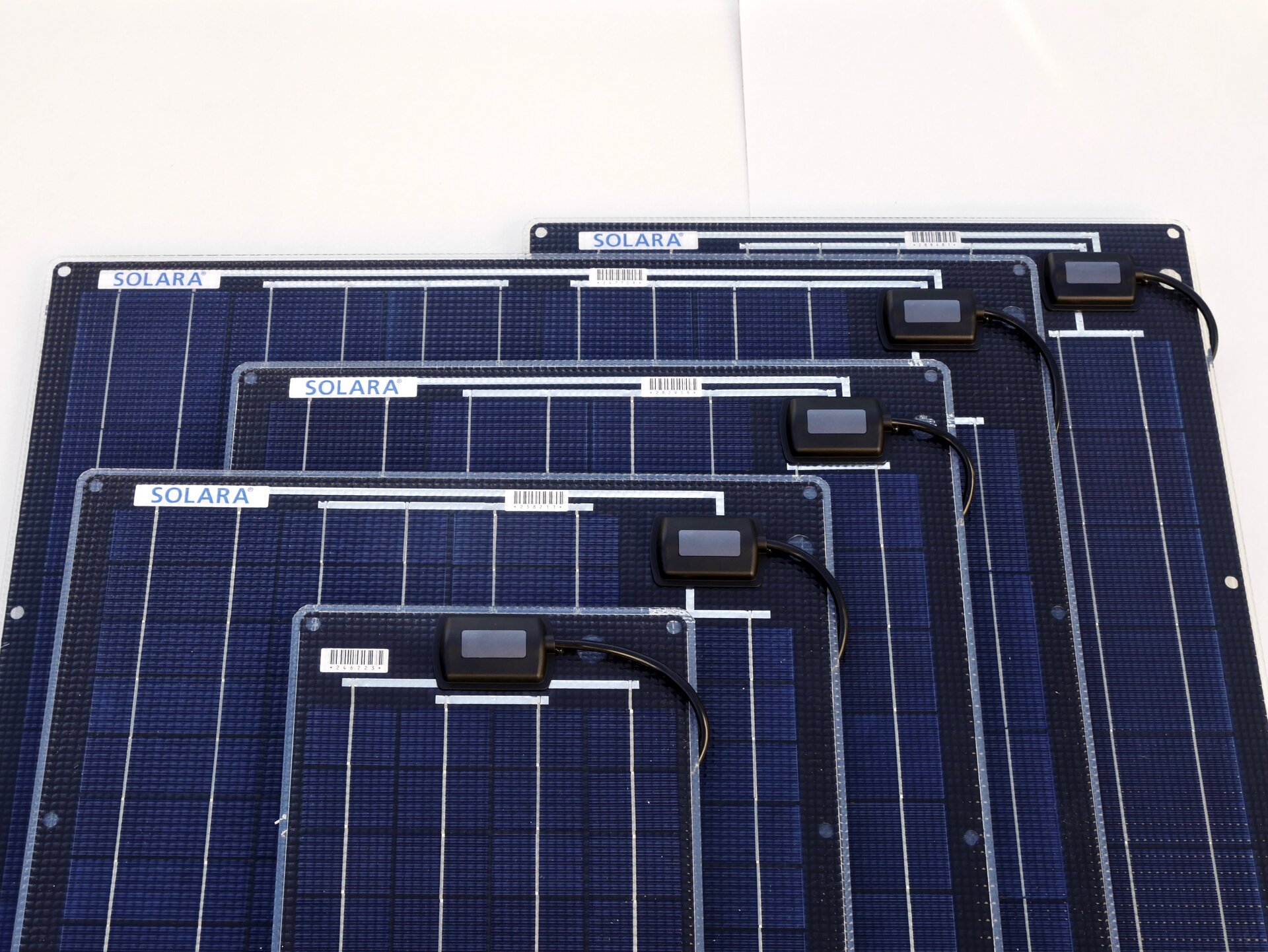Press report
A small selection of news reports about SOLARA and our products in German trade magazines (translated)
Press report on various SOLARA topics

Performance winner:
With a charging current of 6.4 amps within the test setup, the Solara module emerges as the quantitative winner of the test. With a theoretical peak output of 120 watts, this is hardly surprising; here too, together with the Büttner/Dometic module, it is the leading performer. It is quite possible that even more power could be achieved, as the charge controller supplied was only 0.2 amps away from its maximum load and heated up considerably during the test. The low-light behaviour (33% residual power) and the reaction to shadows were also convincing, with a minimum of 22% residual power still measurable. The high price is unfortunate. If this were different – and if there were a more powerful controller – the panel consisting of walk-on laminated modules would be good for a top place in the test.

Solar module in three sizes
The DCsolar Power Flex is now available in three new formats with outputs of 110, 120 and 140 watts. The semi-flexible design adapts to curved roof surfaces thanks to its flexibility. The dimensions are 110 x 54 cm, 99 x 66 cm or 137.5 x 54 cm and are encapsulated with a transparent, robust and durable ETFE film on the front and back to make them weatherproof. Thanks to the aluminium carrier plate, the module is fully walkable on solid ground and heat-resistant, as the heat is reliably dissipated. The solar module is 4 mm thin, weighs between 4.3 and 4.9 kg depending on the size and costs from 469 euros in specialist shops.

Versatile solar modules
The DCsolar-Power-Flex solar modules are available in three sizes with outputs of 110, 120 and 140 watts. They are weatherproofed with a transparent, robust and durable ETFE film on the front and back. This guarantees a long service life even in extreme weather conditions. Thanks to the aluminium carrier plate, the modules can be walked on without any problems on a solid surface and are heat-resistant, as the heat is reliably dissipated. The semi-flexible design also adapts easily to curved surfaces – for example on the cabin roof of a sailing boat. The solar modules are 4 mm thin and weigh between 4.3 and 4.9 kg, depending on their size. A 3-metre cable is permanently installed on each module. The connection to the on-board battery must be made via a charge controller due to the high output. Solara grants a three-year product guarantee on the DCsolar Power Flex solar modules. The modules are available from specialist dealers from 469 euros.

Semi-flexible flat vs. frame modules
Glass frame or semi-flexible flat module? Both systems produce reliable electricity and have different strengths. As a general rule, both concepts have high-quality high-end modules on the market as well as ratty Chinese scrap. The latter will not survive for long on the roof of a camper. In the case of solar panels, the guiding principle is probably even more obvious: If you buy (too) cheap, you buy twice. But you also have to dismantle (flat modules) and reassemble them, which is particularly troublesome.
Glass frame modules (example: Solara Power S series)
The robust 160 Wp module of the Solara Power S series weighs around 9.5 kilograms and costs around 760 euros with a performance guarantee of 20 years.
+ cheaper than flat modules
+ optimally ventilated due to mounting on solar spoilers
+ Under-ventilation optimises efficiency
+ versions with glass of proven and robust quality
+/- cannot be walked on (except Solara S series)
+/- more susceptible to branch contact (except Solara S series)
– More complex installation due to the use of solar spoilers
– heavier (module + bracket)
– significantly higher (65 mm) than flat modules (5 mm)

Pure sun energy
The DCsolar-Power-Flex solar modules are available in three sizes with outputs of 110, 120 and 140 watts. They are weatherproofed with a transparent, robust and durable ETFE film on the front and back. This guarantees a long service life even in extreme weather conditions. Thanks to the aluminium carrier plate, the modules can be walked on without any problems on a solid surface and are heat-resistant, as the heat is reliably dissipated. The semi-flexible design also adapts easily to curved surfaces – for example on the cabin roof of a sailing boat. The solar modules are 4 mm thin and weigh between 4.3 and 4.9 kg, depending on their size. A 3-metre cable is permanently installed on each module. The connection to the on-board battery must be made via a charge controller due to the high output. Solara grants a three-year product guarantee on the DCsolar Power Flex solar modules. The modules are available from specialist dealers from 469 euros.

Interview with Mirko Held (Managing Director of Solara)
Camper:
Anyone who wants to optimise their energy supply in the camper will have to install one or more solar panels. Which question should be asked first?
SOLARA:
Do I have to pay attention to weight or height? This question usually clarifies whether I prefer framed glass or flexible flat modules. And of course the question of budget. Sound flat modules are comparatively expensive.
Camper:
Then comes the question: How much total power do I need on the roof?
SOLARA:
Correct. As always, an honest consumption analysis must be made. Which consumers run for how long per day? This is the basis for the demand module. Roughly speaking, our experience shows: that 100 to 200 Wp are usually needed for camping buses or vans, and larger motorhomes need 200 to 400 Wp as a basic setup.
Camper:
In principle, a combination of glass and semi-flexible flat modules would also be possible?
SOLARA:
Yes, absolutely. Many customers supplement glass modules with semi-flexible ones, or with a mobile folding module if more glass modules would be too big.
Camper:
Which combination would still be critical?
SOLARA:
Combine modules from different manufacturers or modules of different sizes, i.e. with different output voltages. Even a 100 and a 150 from the same manufacturer should not necessarily be placed on one controller.
Camper:
Better one large charge controller than several small ones?
SOLARA:
Yes, already for reasons of redundancy – it is better to have several small ones, especially if different modules are installed.
Camper:
A look at current problems?
SOLARA:
Drivers of panel vans rely heavily on semi-flexible flat modules. They look smart and save weight. However, there are many unsuitable products on the market, extremely many fail and have to be dismantled at great expense. Sometimes bending radii are exceeded and sometimes soldered cell connectors break due to high thermal fluctuations. Solara relies on elaborately soldered, flexible cell connectors and an aluminium sandwich carrier plate as a basis to better dissipate heat and prevent overbending. Anyone who glues modules over their entire surface must be aware that some water can always diffuse through them. Increased moisture under the module can freeze and frost can destroy the cell.

For the windscreen
Solara has developed the DCsolar OBD-2 battery charger. This is used for trickle-charging the battery and thus prevents self-charging during longer downtimes. The solar module measures 35 x 25 centimetres, has an output of 13 Wp and is installed on or behind the windscreen using suction cups. It can be connected to the standardised OBD 2 connection in the vehicle without specialist knowledge. The integrated charge controller prevents the battery from overcharging. The monocrystalline high-tech solar cells generate solar power even in low light. Price: from 79.90 euros.

DCsolar OBD2 battery charger
Solara has developed the DCsolar OBD-2 battery charger. This is used for trickle-charging the battery and thus prevents self-charging during longer downtimes. The solar module measures 35 x 25 centimetres, has an output of 13 Wp and is installed on or behind the windscreen using suction cups. It can be connected to the standardised OBD 2 connection in the vehicle without specialist knowledge. The integrated charge controller prevents the battery from overcharging. The monocrystalline high-tech solar cells generate solar power even in low light. Price: from 79.90 euros.

Solara DCsolar Power Flex solar module: Now in three sizes
The DCsolar Power Flex is now available in three new formats with outputs of 110, 120 and 140 watts. The semi-flexible design adapts to curved roof surfaces thanks to its flexibility. The dimensions are 110 x 54 cm, 99 x 66 cm or 137.5 x 54 cm and are encapsulated with a transparent, robust and durable ETFE film on the front and back to make them weatherproof. Thanks to the aluminium carrier plate, the module is fully walkable on solid ground and heat-resistant, as the heat is reliably dissipated. The solar module is 4 mm thin, weighs between 4.3 and 4.9 kg depending on the size and costs from 469 euros in specialist shops.

OBD2
The Solara DCsolar OBD2 battery charger makes it particularly easy to keep the starter battery happy. Attach the module to the windscreen, plug the cable into the OBD connector (easily accessible at the bottom of the dashboard) – and you’re done. At the heart of the concept: a flat module measuring 35 x 25 centimetres and weighing just 590 grams with an output of 13 Wp – sufficient power and is installed on or behind the windscreen using suction cups. It can be connected to the standardised OBD 2 port in the vehicle without any specialist knowledge. The integrated charge controller prevents the battery from overcharging. The monocrystalline high-tech solar cells generate solar power even in low light. Price: from 79.90 euros.

For the windscreen
Solara has developed the DCsolar OBD-2 battery charger. This is used for trickle-charging the battery and thus prevents self-charging during longer downtimes. The solar module measures 35 x 25 centimetres, has an output of 13 Wp and is installed on or behind the windscreen using suction cups. It can be connected to the standardised OBD 2 connection in the vehicle without specialist knowledge. The integrated charge controller prevents the battery from overcharging. The monocrystalline high-tech solar cells generate solar power even in low light. Price: from 79.90 euros.

Versatile solar modules
The DCsolar-Power-Flex solar modules are available in three sizes with outputs of 110, 120 and 140 watts. They are weatherproofed with a transparent, robust and durable ETFE film on the front and back. This guarantees a long service life even in extreme weather conditions. Thanks to the aluminium carrier plate, the modules can be walked on without any problems on a solid surface and are heat-resistant, as the heat is reliably dissipated. The semi-flexible design also adapts easily to curved surfaces – for example on the cabin roof of a sailing boat. The solar modules are 4 mm thin and weigh between 4.3 and 4.9 kg, depending on their size. A 3-metre cable is permanently installed on each module. The connection to the on-board battery must be made via a charge controller due to the high output. Solara grants a three-year product guarantee on the DCsolar Power Flex solar modules. The modules are available from specialist dealers from 469 euros.

Interview with Mirko Held (Managing Director of Solara)
Camper:
Anyone who wants to optimise their energy supply in the camper will have to install one or more solar panels. Which question should be asked first?
SOLARA:
Do I have to pay attention to weight or height? This question usually clarifies whether I prefer framed glass or flexible flat modules. And of course the question of budget. Sound flat modules are comparatively expensive.
Camper:
Then comes the question: How much total power do I need on the roof?
SOLARA:
Correct. As always, an honest consumption analysis must be made. Which consumers run for how long per day? This is the basis for the demand module. Roughly speaking, our experience shows: that 100 to 200 Wp are usually needed for camping buses or vans, and larger motorhomes need 200 to 400 Wp as a basic setup.
Camper:
In principle, a combination of glass and semi-flexible flat modules would also be possible?
SOLARA:
Yes, absolutely. Many customers supplement glass modules with semi-flexible ones, or with a mobile folding module if more glass modules would be too big.
Camper:
Which combination would still be critical?
SOLARA:
Combine modules from different manufacturers or modules of different sizes, i.e. with different output voltages. Even a 100 and a 150 from the same manufacturer should not necessarily be placed on one controller.
Camper:
Better one large charge controller than several small ones?
SOLARA:
Yes, already for reasons of redundancy – it is better to have several small ones, especially if different modules are installed.
Camper:
A look at current problems?
SOLARA:
Drivers of panel vans rely heavily on semi-flexible flat modules. They look smart and save weight. However, there are many unsuitable products on the market, extremely many fail and have to be dismantled at great expense. Sometimes bending radii are exceeded and sometimes soldered cell connectors break due to high thermal fluctuations. Solara relies on elaborately soldered, flexible cell connectors and an aluminium sandwich carrier plate as a basis to better dissipate heat and prevent overbending. Anyone who glues modules over their entire surface must be aware that some water can always diffuse through them. Increased moisture under the module can freeze and frost can destroy the cell.

Neues Power Flex Solarmodul
Solara now offers the DCsolar Power Flex in three sizes (110 x 54 cm/99 x 66 cm/137.5 x 54 cm) in the power levels 110, 120 and 140 watts with reliable technology. The solar modules are encapsulated with a transparent, robust and durable ETFE film (ethylene tetrafluoroethylene copolymer) on the front and back to make them weatherproof. This guarantees a long service life even in snow and hail. Thanks to the aluminium carrier plate, the module is fully walkable and heat-resistant on solid surfaces. The module is four millimetres thin and weighs between 4.3 and 4.9 kilograms, depending on the size. The semi-flexible modules also adapt to curved roof surfaces. The powerful monocrystalline SunPower solar cells guarantee excellent efficiency and therefore high area yields, even in poor light conditions. Solara provides a three-year product guarantee on the modules. The price: from 469 euros.

Complete sets with module and charge controller
SOLARA offers their solar energy set also as a complete set with a Votronic charge controller. The Votronic solar charge controller of the SR-series has an overload protection and can be used for any type of battery (acid, gel, AGM, LiFePO4). An EBL-adapter cable is included in the package, it can be used to connect to an electronic block of the vehicle for visualisation of the solar energy. A solar module, ABS-spoiler to mount on a roof, introductions, adhesive set, solar cable and roof duct are also included in the set. The complete set is available from 449 Euros.
Solar panels help rescue life. Since eight years solar panels supply electricity under extreme conditions in the Indian Ocean for early detection of tsunamis. Measuring stations at sea monitor the ocean with sonar (sound navigation and ranging) for changes to predict tsunamis. The data is sent to a station on-shore which is also provided with electricity by SOLARA modules. With this system the inhabitants can be warned early in case of a tsunami and go to shelter.
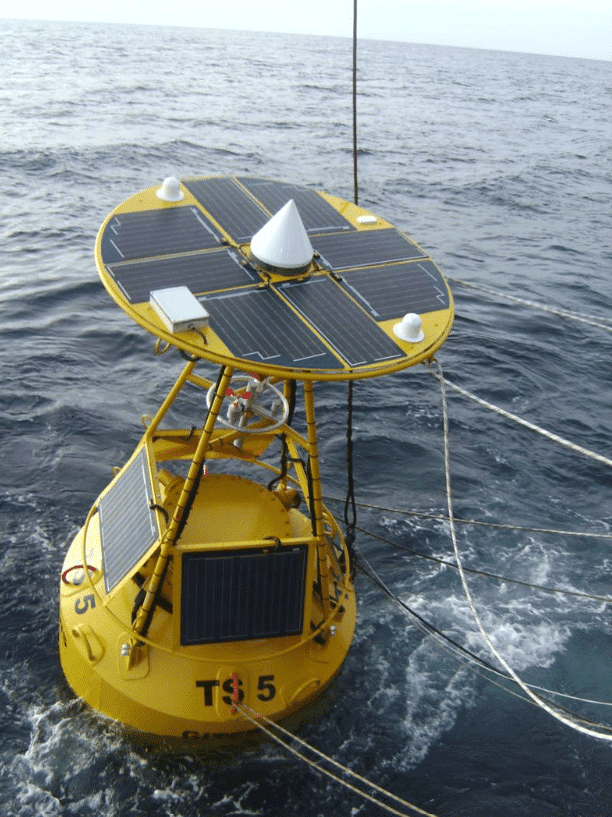
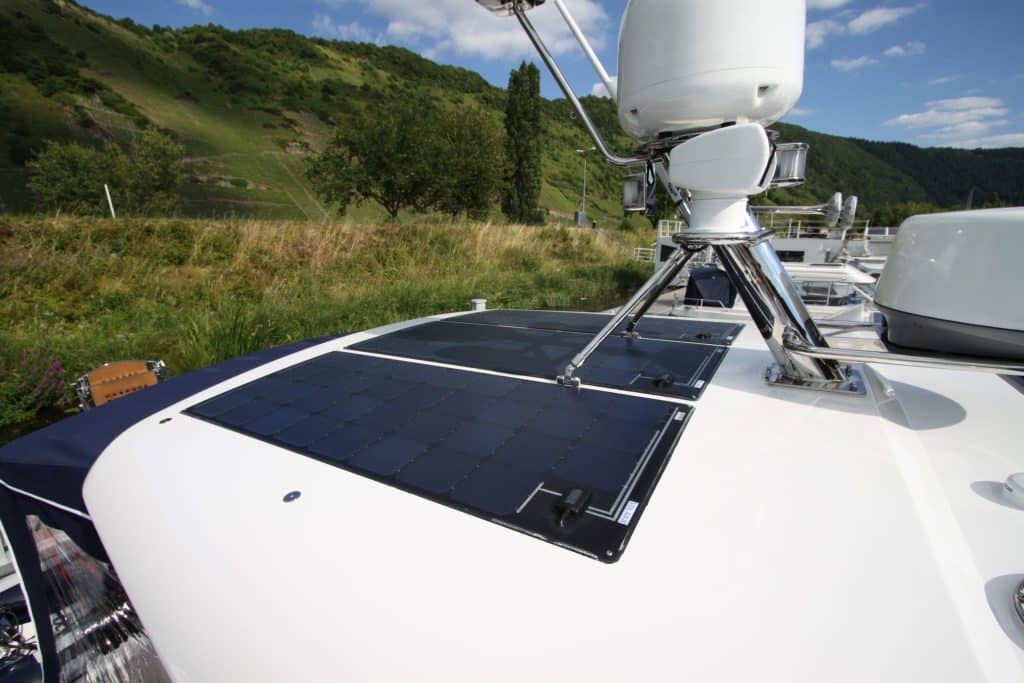
New powerful solar modules from SOLARA
Excellent for sailboats – walkable and seawater resistant
SOLARA’s solar modules, which will be available this spring, are only 3 mm thick and weigh just 4 to 5 kg. Due to the particularly flat design, they can be bent and fully walked on. The surface consists of a new type of weather-resistant and dirt-repellent special foil. A high solar cell density ensures sufficient voltage to charge the battery even at high temperatures. In addition, the silver conductor tracks on the surface of the cell were dispensed with so that more light falls on the monocrystalline high-performance cells. This means that the solar module generates over 20% more electricity than conventional solar modules on the same surface. SOLARA therefore also calls the product the Power M series. There are three sizes with an output of up to 140 watts/peak. In summer, you can generate an average of 560 watt hours of electricity per day. The SOLARA Power M series is available in good specialist shops from 938€.
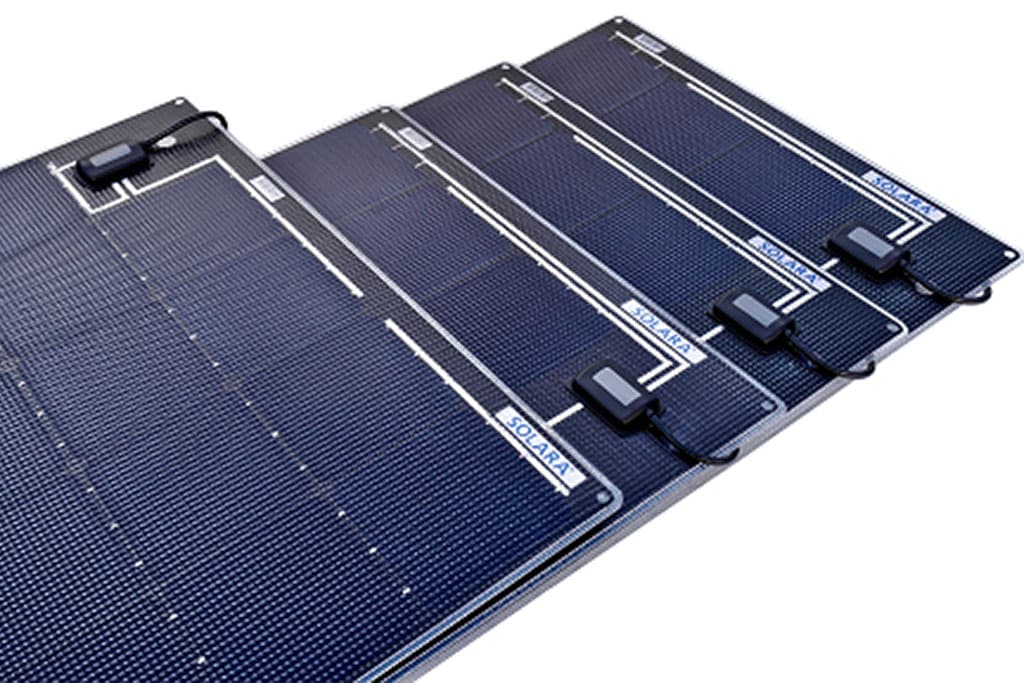
ShipShop / New products
Flat and powerful
The company Solara has developed solar modules with the name Power M, which are only 3 millimetres thick and are also relatively light with a weight of 4 to 5 kilograms. The panels flex moderately and are walkable, so they should be well suited for deck mounting. Their surface consists of a transparent, weather-resistant and dirt-repellent film, which makes the panels insensitive to mechanical damage and environmental influences, and regular cleaning should also be unnecessary. According to the manufacturer, the increased number of built-in solar cells and the omission of silver conductors on their surface meant that the power output could be increased by more than 20 percent compared to previous modules on the same surface. Three sizes are currently available with an output of up to 140 watts/peak, which can generate an average of 560 watt hours of electricity per day in northern European summer. The Solara Power M series can be obtained from specialist dealers, prices start at EUR 938 including sales tax.

Stock exchange news: Discovered at SOLARA
Particularly flat and powerful solar modules
With particularly flat and powerful solar modules, the company SOLARA has created the perfect solution for expedition vehicles. The 3 to 4 millimetre thick modules only weigh a maximum of 5 kilograms and still deliver over 20% more electricity than conventional solar cells. In summer, an average of 560 watt hours of electricity per day is possible. The SOLARA Power M series is available from 938 euros.

SOLARA – Lighter and more powerful
SOLARA Power M-Serie
The laminated solar modules from Solara had two flaws: their high weight and the somewhat lower performance compared to classic glass modules (see also test in EXPLORER 1/2014). The German company is now closing this gap with the so-called Power-M series. Aluminium instead of stainless steel as the carrier plate, with up to 43 cells on top – this is supposed to make 20 percent more electricity yield possible, with noticeably less weight. Available with 110 to 140 watts of power from 938 euros.
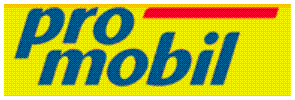
Extraordinary at the Caravan Salon 2016
The most unusual discoveries
Benjamin Köbler-Linsner: “I was surprised by the Solara windshield cover. The cover made of thick material protects the vehicle interior from heating up too much when the sun is shining. In addition, you can zip in a solar panel to generate electricity.”

New accessories 2017
SOLARA Mobile Solar Module
The S409M32 Mobil Plus by Solara attaches to the frame of the windshield with magnets. The combination of solar panels and insulation mat is equipped with closed-cell foam in the core, thus effectively keeping the heat out of the car and withstanding wind and weather. The solar module with 102 watts of output can also be set up flat with thin sail battens if required, or removed with zip ties and placed in the sun. For example, if you want to park the van in the shade. Solara can supply the module with an integrated charge controller and theft protection on request. The particularly light-sensitive cells are said to impress with their special efficiency. Five-year warranty, made in Germany. The mats are sewn by Camper Projekt from Hamburg. Currently available at a price of 1,199 euros, the 6.5-kilogram mat/solar combination will cost 1,299 euros in 2017.

20 years of Solara
The success story with solar energy looks back on two decades of consistency. Solara, the Hamburg-based company, was founded in 1996 by Thomas Rudolph. After eight years in a shop for engineering products, he was infected with the solar virus. His version: “When my children are big, solar systems should be normal on mobile homes and even on houses.” Today they are indispensable on both.

20 years of Solara
From the very beginning, Thomas Rudolph focused on off-grid applications when he founded Solara together with Hans Jacobs in 1996. Frank Heise, now a managing partner, was already there at the time. Expert advice made it possible to take away the initial scepticism from customers about the technology, which was initially still quite young – transparent depictions of the realistic yield did the rest. Customer experiences were in turn passed on to the producers. Solara entered international business just one year after its foundation. Soon the premises at the headquarters – a shop with office and warehouse in Hamburg-Eimsbüttel – became too small and the company moved to Hamburg-Altona. In 2001, the Solara solar power plant started production, which was set up with the support of the physicist Ralf Hennings. The Wismar production site soon employed over 200 people. After having teamed up with other companies for CentroSolar AG in the meantime, Solara is now performing independently again. The modules still come from Wismar and have proven their worth especially in off-grid applications.

Screen-energy
With Solara’s combination solution, energy is generated on the windscreen. While it is covered and isolated.
Combined solutions are always a good idea in a motorhome. Solar system specialist Solara connects a flexible solar panel with a cover mat for the windscreen in 2017. This set is called Power Mobil Plus.
The insulated mat was developed in collaboration with Projekt Camper and is completely opaque. It is attached to the window with magnets outside the vehicle. The solar panel is attached to the mat with a high-quality YKK zipper. The module produces 102 watts, the cable is routed anywhere in the vehicle and connected to the battery. It is also possible to change the angle of inclination of the solar panel without having to lift the mat off the pane. A security cable with combination lock protects the solar cell from occasional thieves.
The cover is ideal for winter campers when snow covers the solar cells on the roof. This year the set costs 1199 euros, in 2017 the price for the Power Mobil Plus rises from 1299 euros.
Conclusion: great idea. How much power the solar panel really brings could not be tested at the fair.

20 years of Solara
The success story with solar energy looks back on two decades of consistency. Solara, the Hamburg-based company, was founded in 1996 by Thomas Rudolph. After eight years in a shop for engineering products, he was infected with the solar virus. His version: “When my children are big, solar systems should be normal on mobile homes and even on houses.” Today they are indispensable on both.

… at Walther Grauerholz, one of the three managing partners of Solara
The solar system specialist Solara celebrates its 20th anniversary. What was the biggest challenge in the two decades?
20 years ago, solar power generation (photovoltaic) for mobile homes was fairly unknown. There was great scepticism as to whether the then very expensive solar technology would reliably produce electricity for many years. We didn’t promise too much at the time. Even today there are Solara solar systems that work reliably even under extreme conditions on mountain huts and sea markers. Today, simple assembly and high electricity yield are the most important. Solara has mounting systems and new high-performance solar panels with back-contact solar cells at affordable prices.
Solara sells its products worldwide, but remains loyal to German locations. What is the meaning of Made in Germany?
Those who use solar technology are mostly dependent on (solar) electricity. The most important thing is absolute reliability of all components. We can only ensure that with our production in Germany and our many years of experience.
The demand for solar systems for homes is dependent on the funding. Is the camping industry a good mainstay?
Our specialist dealers and motorhome owners exchange information about Solara products. Just because we have always delivered excellent solar technology has made it a very stable mainstay for us with good annual sales growth.
How will we see solar technology in the future? Would it be conceivable to integrate the panels into the body wall?
Solar power generation is becoming more and more individual, and the multiple benefits are becoming more important. Our latest solar module Power Mobile Plus is the best example. It can shade the windshield and produce electricity. If the vehicle is already in the shade, you can remove the solar panel and place it directly in the sun. Solar panels integrated in the vehicle are absolutely conceivable. The extremely flat, walk-in and semi-flexible M-series comes very close to that.

Flat solar panels
Solara offers new, particularly flat solar panels. They are only three millimetres thick and weigh four to five kilograms. The flat design means that they should be easy to bend and, above all, should not generate any additional noise while driving. The panels are also equipped with a transparent and weatherproof, dirt-repellent special film. Advantage: They do not need to be cleaned and are not prone to falling rocks. So that the panel builds up enough voltage to charge the battery even at very high temperatures, Solara equips it with significantly more than the usual 36 cells.
In addition, the company deliberately does not use the silver conductor tracks on the surface of the cells so that more light falls on the monocrystalline high-performance cells. As a result, the solar panel should generate over 20 percent more electricity than conventional solar panels on the same area. The panel is available in three sizes with an output of up to 140 watts peak. In summer, it can generate an average of 560 watt-hours of electricity a day. The module costs 938 euros.

With solar cells on the sunny side
The new Solara S-series vision cells not only perform in bright sunshine, but also in diffuse light and in low-light months. The panels consist of 36 high-performance cells, which are inserted and accessible in a robust, seawater-resistant aluminium profile frame. Drainage holes in the frame prevent frost damage, a special film protects against scratches.

Charge controllers are the heart of a solar power system. The new Solara SR280E MPPT charge controller automatically adjusts the input voltage optimally to the battery voltage. As a result, the solar system can always achieve maximum performance.

Strong double
The Power Mobil Plus from Solara is a solar panel and windshield cover in one. In this way, the vehicle is protected from excessive heating in summer and at the same time generates electricity. The mobile solar panel is suitable for VW T5 / T6, Mercedes-Benz Vito and Fiat Ducato and costs 1,299 euros. Thanks to its magnet system, the module can be quickly assembled and disassembled and easily attached above the windscreen. The Power Mobil Plus consists of two solar panels with a total of 102 Wp and weighs 7.1 kg. Also new at Solara: the SR280E charge controller. It automatically adjusts the input voltage optimally to the battery voltage, so that the solar system always delivers the maximum output. In addition, the MPPT charge controller protects the battery against overvoltage and deep discharge. Three LEDs provide information about the charging status, battery voltage and load status. The SR280E with up to 85 volts and 16 amps is available for 130 euros. A smaller version with 12 volts and 16 amps is available from 36 euros.

Strong double
The Power Mobil Plus from Solara is a solar panel and windshield cover in one. In this way, the vehicle is protected from excessive heating in summer and at the same time generates electricity. The mobile solar panel is suitable for VW T5 / T6, Mercedes-Benz Vito and Fiat Ducato and costs 1,299 euros. Thanks to its magnet system, the module can be quickly assembled and disassembled and easily attached above the windscreen. The Power Mobil Plus consists of two solar panels with a total of 102 Wp and weighs 7.1 kg. Also new at Solara: the SR280E charge controller. It automatically adjusts the input voltage optimally to the battery voltage, so that the solar system always delivers the maximum output. In addition, the MPPT charge controller protects the battery against overvoltage and deep discharge. Three LEDs provide information about the charging status, battery voltage and load status. The SR280E with up to 85 volts and 16 amps is available for 130 euros. A smaller version with 12 volts and 16 amps is available from 36 euros.

Charge controller for 85 Voltage
Solara has a new charge controller for solar power systems in its range. The SR280E MPPT controller automatically adjusts the input voltage to the battery voltage. As a result, the solar system is to provide maximum performance and the battery is protected against overcharging and deep discharge. The charge controller has three LEDs that inform the motorhome about the charging status, battery voltage and the load status. The housing is completely potted and protected against moisture. The charge controller SR280E is designed for a maximum voltage of 85 volts and a current of 16 amps. The price is 130 euros. There is also a simple version with 12 volts and 16 amps for 36 euros. Both controllers are already available.

Electricity for two
The Solara charge controller SR-350DUO charges two batteries at the same time with a solar system – for example the living area and the starter battery of the motorhome. Different battery types such as AGM and LiFePO4 batteries can be charged at the same time. The four-stage charging process with temperature compensation, external sensor and overcharge protection should guarantee optimal charging. Users can read the energy flows and the charge status of the batteries on an LCD display. The SR320DUO also has various control, programming and acoustic warning functions. The controller is suitable for twelve and 24 volt systems with a charging current of up to 20 amperes. The electronics are encapsulated in the housing and protected against moisture, the controller is suitable for fixed installation. Price 169 euros.

Good combination
Self-sufficient camping enables the windscreen cover “Power Mobil plus” in combination with the MPPT charge controller. “The cover can be stowed away quickly, is opaque and can be had for 1199 euros. The charge controller is available from 36 euros.

Electricity for two
Solara charge controller
The Solara charge controller SR-350DUO charges two batteries at the same time with a solar system – for example the living area and the starter battery of the motorhome. Different battery types such as AGM and LiFePO4 batteries can be charged at the same time. The four-stage charging process with temperature compensation, external sensor and overcharge protection should guarantee optimal charging. Users can read the energy flows and the charge status of the batteries on an LCD display. The SR320DUO also has various control, programming and acoustic warning functions. The controller is suitable for twelve and 24 volt systems with a charging current of up to 20 amperes. The electronics are encapsulated in the housing and protected against moisture, the controller is suitable for fixed installation. Price 169 euros.

Unbuttoned: mobile solar panels from Solara
With their textile edging, the compact modules can be easily attached to sprayhood or bimini and just as easily stowed away
The panels are equipped with Sunpower solar cells on the back and are said to have an efficiency of over 22 percent. The output of the module assembly, which measures around 69 by 63 by 2.5 centimetres, is given as a 102 watt peak. This should allow a little more than 400 watt hours of energy to be gained on a summer day in our latitudes.
The attachment is possible with Velcro, zipper, eyelets or Tenax / LOXX buttons. The weight is given as 4.9 kg. The recommended retail price is 859 euros.

Complete set with module and controller
Solara now also offers its solar power sets as a complete package with a Votronic charge controller. The Votronic solar controllers of the SR-series have overcharge protection and a recharge circuit when power is being used and are suitable for all types of batteries (acid, gel, AGM, LiFeP04). To visualise the solar power, an EBL-adapter cable for connection to the electro block in the vehicle is included in the scope of delivery. In addition to the charge controller, the set also includes a Solara solar panel and ABS retaining spoiler for roof mounting, as well as assembly instructions, an adhesive set, solar cable and roof duct. The complete set is available from 449 euros.

10 questions for …
Frank Heise, SOLARA
What’s new in 2019?
Particularly robust solar panels for special applications, e.g. our speciality is for marine signs, external measuring stations and of course off-road vehicles. That is why we are planning further glass-glass solar panels.
The next project?
Tailor-made solutions for different vehicles.
Which product was a hit so far?
Fortunately, we didn’t have a so-called bum. Our fastening systems are an absolute hit.
When and how did you get off-road fever?
Adventure & 4WD 2014. It became clear to us that our robust solar panels are also ideal for off-road vehicles.
Which off-roader do you drive privately?
Offroad often and with pleasure on my mountain bike and while running. However, I don’t (yet) have an off-roader.
And which one would you like to have?
A Defender or Toyota Land Cruiser. However, I have not yet committed myself. There is still considerable need for experience and advice.
If we were to send you on a trip now, you would go to …
The balcony would definitely be my first travel destination.
Why should the customer come to you of all places?
We are certainly one of the solar companies in Germany with the longest and greatest experience of over 20 years! I personally have been in the industry for more than 20 years and vouch for our products so that they keep what we promise!
Your company in three words?
Experience – quality awareness – fast

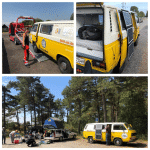 Many thanks to DCSolar (a brand of SOLARA GmbH) for providing a mobile solar system! Whether during a break or, as in my case, during a forced break due to a breakdown in front of a workshop: in any case, you are supplied with enough energy to keep all telephones and
Many thanks to DCSolar (a brand of SOLARA GmbH) for providing a mobile solar system! Whether during a break or, as in my case, during a forced break due to a breakdown in front of a workshop: in any case, you are supplied with enough energy to keep all telephones and

Fill up with sunshine
At most in the deepest wilderness, away from any power sources, photovoltaic systems ensure the power supply of the campervan. Solara is a specialist for off-grid power supply with photovoltaics. The Hamburg company has around ten different solar modules of the Solara M and Power M series in its range. What they all have in common is that with four millimetres they are extremely flat (no driving noise), particularly light (from 900 grams) and available without frames for glueing on, so that no screw-on or mounting system is required. This makes them perfect for quickly upgrading your camper for even more independence on the road. The weather- and saltwater-resistant solar modules with the dirt-repellent surface are now available with even more power (twelve to 150 watts) and are available from 289 euros.

Solara (Hamburg) developed solar panels in the M-series, which thanks to new cells offer seven percent more power than before. This means, conversely, that the panels can be smaller for the same output so that they also fit smaller areas onboard and thanks to their flexibility they can also adapt curves. They are also slip-resistant thanks to their anti-slip structure. The panels are available in ten power classes from twelve to 150 watts nominal power.

Tried and tested: Mobile solar system from SOLARA
The modules are equipped with solar cells from Sunpower mounted on the back and are said to have an efficiency of over 22 percent. The output of the module array, which measures approximately 69 x 63 x 2.5 centimetres, is specified as 102 Watt peak. On a summer’s day in our latitudes, it should be possible to generate slightly more than 400 watt-hours of energy. It can be fastened with Velcro, zip, eyelets or Tenax-/LOXX-buttons. The weight is stated as 4.9 kilograms. The recommended price is 859 euros.

Tried and tested: Mobile solar system from SOLARA
As a rule, solar systems are permanently installed. However, in some cases, a mobile solution can be useful – for example, if you usually stay overnight with electricity and only occasionally need more self-sufficiency, want to use the solar system with different vehicles, have no space on the roof or appreciate the possibility of placing the solar panel in the sun but park the mobile in the shade. Especially during winter camping – where we have tried the Solara-Power-Mobil-Plus-Set – two more advantages become apparent: It is easier to clear the panel of snow on the windscreen than when it is mounted on the roof. In addition, the inclined installation fits the winter sun position better.
The Solara set is cleverly combined with an insulating mat for the windscreen. This is fixed to the windscreen frame with the help of a Velcro strip running through the driver’s cab and sewn-in magnets in the edge of the mat. The mat helps to keep the heat inside in winter and outside in summer. It also has sewn-on tabs into which the foldable solar panel can be inserted. An enclosed steel cable with combination lock also ensures that thieves are deterred. The five-metre-long connecting cable is connected to the panel via a plug and fed through the rubber seal of a cab door or body window to the inside. The other end is simply plugged into one of the 12 V sockets in the body via a cable-connected solar charge controller. Alternatively, it can be connected to a permanently installed charge controller. During the practical test in the Allgäu region of Bavaria, the 102 Wp module managed to refill the battery, which is about half full according to the control board, to 75 percent over a sunny day. The Solara-Power-Mobil-Plus-Set is available tailor-made for the VW Transporter, Mercedes Vito and Fiat Ducato. With a charge controller, it costs 1124.90 euros – in other words, similar to a permanently installed system.

More Power
Solara now offers Solara M-Series solar modules with 7 percent more power and ten different output classes. They have a very flat design, do not require a frame, can be glued on without screwing on and are designed to be walkable and non-slip. There is a choice of outputs between 12 and 150 watts, the smallest version weighs 900 grams. A further advantage of the M-series is a large number of cells, which ensures a higher voltage for efficient charging even at high temperatures. With front and rear foil welded at the edges, hotspot cell protectors with protective diodes and special cell connectors, a particularly long service life are to be guaranteed. In addition, the…

Frameless
Solara has revised the M series and now offers the solar modules without a frame and for glueing on. In addition, the new generation is said to have seven percent more power. The modules are available in ten power classes between 12 and 150 watts and weigh from 900 grams upwards. The glued-on solar modules are supposed to be walkable and non-slip and can therefore also be glued onto the deck or superstructure – as long as the surface is stable and flat. Since the modules are somewhat flexible, they can adapt to slight curves such as the deck. Solara gives a five-year product guarantee on the modules. The price starts at 289 euros.

New solar modules
SOLARA M-series solar modules (flat, semi-flexible, without frame for sticking on and walking on) now with 7% more power and in ten different power classes.
SOLARA now has ten different solar modules of this type with outputs between 12 and 150 watts and a weight starting at 900 grams.
SOLARA solar modules without frames can simply be glued or screwed on directly. With a stable surface and flat mounting, the solar modules of the M series can be walked on and are non-slip. A mounting system is not necessary. In addition, these solar modules are slightly flexible and therefore ideal for sailing boats. Since the solar modules are particularly flat without a frame, the superstructure is not raised and there is no tripping hazard.
The solar modules of the SOLARA m-series and Power M-series have around 7% more power due to more powerful crystalline solar cells. The more powerful Power M-series solar modules have over 23% efficiency due to monocrystalline SunPower solar cells with rear contacts. In addition, due to a large number of cells, the M-series has a higher voltage, which provides sufficient voltage to efficiently charge a 12 V battery even at high temperatures.
The unchanged and proven module construction with ETFE edge-welded front and back foil, hotspot cell protector with protective diodes and innovative cell binders ensure long service life. SOLARA provides a five-year product guarantee. The solar modules of the SOLARA M series have been manufactured in Germany with the implementation of innovations for over 20 years and have proven themselves on sailing boats, sea marks, expeditions and much more.
All SOLARA solar modules are robust, absolutely weather and salt water-resistant.
The lightweight solar modules without frames (SOLARA M-Series and Power M-Series, as well as DCSolar Power Flex) are available from specialist dealers from 289 euros.

Lightweight, robust and high performance
The new Solara M-series solar modules now offer seven percent more power. They are available in ten different power classes and sizes. The modules are flat, semi-flexible, without a frame and are glued directly onto the roof. The solar modules of this type have outputs between 12 and 150 watts and start at a weight of 900 grams. With a stable substrate and flat mounting, the Solarmodules of the M-series are walkable and non-slip. A mounting system is not necessary. In addition, the solar modules are particularly light and therefore ideal for vans, campers, panel vans and camping buses. As the solar modules without frame are particularly flat, the body is hardly raised, there are no tripping hazards and no driving or air noises are generated. The lightweight solar modules without frames are available from specialist dealers from 289 euros.
Solara has been involved in generating electricity from sunlight for almost 25 years. Together with his friend and colleague Hans Jacobs, Thomas Rudolph founded Solara in 1996 when he was just 32 years old. After the first steps had taken place in Thomas Rudolph’s garage and living room, it was clear that a real office with a warehouse and a small shop was needed. A suitable domicile was quickly found in Hamburg-Eimsbüttel, Germany.
In the beginning, the founders concentrated almost exclusively on the boat and motorhome market in Germany. They had stands at all the relevant trade fairs and intensive contacts with resellers quickly led to success. “We overcame the scepticism about solar energy and ignorance about its great advantage by emphasising the benefits rather than the technology”, Thomas Rudolph recalls.
Because of the success, the company’s premises soon became too small and the next move to Hamburg-Altona was already on the cards in 1999. In the meantime, the turnover had risen to several million D-Marks. Finally, the company set up its own production facilities. In 2001, Solara’s solar power factory started production. Solara was one of the first big players in Europe. In 2004, a trade magazine not only named Solara the best brand of the year but also supplied the solar modules for what was then the world’s largest rooftop installation for BMW in Dingolfing, Bavaria Germany. Production was constantly expanded, culminating in 2008 in the company`s own 20,000 square metres building in Wismar with a capacity of several hundred megawatts and over 200 employees in Wismar.
To cope with this rapid growth, Solara had merged with other companies in 2006 to form CentroSolar AG under the listed CentroSolar Group AG. By now, Solar has left the CentroSolar Group. Solara continues to be successful with its off-grid applications, such as for sailboats and motorhomes but now also for exceptional electrification in Africa, for expeditions and much more. The company has returned to its headquarters in Hamburg Altona with a revised product portfolio. As before, Solara solar modules come from the solar power factory in Wismar, Germany.
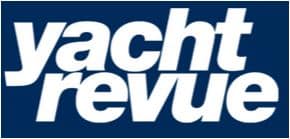
Increased performance
SOLARA. The new solar modules of the Solara M-series and Power M-series offer around seven percent more power due to more powerful crystalline solar cells. The modules are flat, semi-flexible, frameless, walkable and non-slip, making them suitable for mounting directly onto the deck. The proven module design with ETFE at the edge welded front and rear foil, hotspot cell protector with protective diodes and innovative cell connectors ensure long service life. Available with an output between twelve and 150 watts. Weight: from 900 grams. Five-year product guarantee. Price from 289 Euro.

Flat solar modules. With the M series, Solara has frameless, only four millimetre thick solar modules in its range. There is no need for a mounting system. The panels are just glued or screwed onto the roof. Ten different sizes are available with nominal outputs from 12 to 150 Wp. The panels weigh between 900 grams and 5.2 kilos and can be ordered from 289 euros.

Solar cells are a proven solution for being self-sufficient from the electricity grid. Especially if you plan to stay overnight for several days outside campsites, you quickly reach the limits of charging the on-board battery. Solar modules from Solara, for example, are characterised by their ease of installation: They can be glued or screwed on. With a stable surface and flat mounting, it can even be walked on the modules of the M-series (price: from 289 euros) and they are non-slip. A separate mounting system is not necessary.
WALKABLE, NON-SLIP SOLAR MODULES
Solar modules from Solara are characterised, among other things, by their simple installation: They can be glued or screwed on. With a stable substrate and flat mounting, the modules of the M series are even walkable and non-slip – a separate mounting system is not necessary. Due to their low weight, they are ideally suited for vans, campers, panel vans and camping buses. As the solar modules have no frame and are therefore particularly flat, the mounting is not raised, there is no tripping hazard and no driving or air noise is generated.
The modules are available from 289 euros.
Press reports on the company’s 20th anniversary

… at Walther Grauerholz, one of the three managing partners of Solara
The solar system specialist Solara celebrates its 20th anniversary. What was the biggest challenge in the two decades?
20 years ago, solar power generation (photovoltaic) for mobile homes was fairly unknown. There was great scepticism as to whether the then very expensive solar technology would reliably produce electricity for many years. We didn’t promise too much at the time. Even today there are Solara solar systems that work reliably even under extreme conditions on mountain huts and sea markers. Today, simple assembly and high electricity yield are the most important. Solara has mounting systems and new high-performance solar panels with back-contact solar cells at affordable prices.
Solara sells its products worldwide, but remains loyal to German locations. What is the meaning of Made in Germany?
Those who use solar technology are mostly dependent on (solar) electricity. The most important thing is absolute reliability of all components. We can only ensure that with our production in Germany and our many years of experience.
The demand for solar systems for homes is dependent on the funding. Is the camping industry a good mainstay?
Our specialist dealers and motorhome owners exchange information about Solara products. Just because we have always delivered excellent solar technology has made it a very stable mainstay for us with good annual sales growth.
How will we see solar technology in the future? Would it be conceivable to integrate the panels into the body wall?
Solar power generation is becoming more and more individual, and the multiple benefits are becoming more important. Our latest solar module Power Mobile Plus is the best example. It can shade the windshield and produce electricity. If the vehicle is already in the shade, you can remove the solar panel and place it directly in the sun. Solar panels integrated in the vehicle are absolutely conceivable. The extremely flat, walk-in and semi-flexible M-series comes very close to that.

20 years of Solara
The success story with solar energy looks back on two decades of consistency. Solara, the Hamburg-based company, was founded in 1996 by Thomas Rudolph. After eight years in a shop for engineering products, he was infected with the solar virus. His version: “When my children are big, solar systems should be normal on mobile homes and even on houses.” Today they are indispensable on both.

Screen-energy
With Solara’s combination solution, energy is generated on the windscreen. While it is covered and isolated.
Combined solutions are always a good idea in a motorhome. Solar system specialist Solara connects a flexible solar panel with a cover mat for the windscreen in 2017. This set is called Power Mobil Plus.
The insulated mat was developed in collaboration with Projekt Camper and is completely opaque. It is attached to the window with magnets outside the vehicle. The solar panel is attached to the mat with a high-quality YKK zipper. The module produces 102 watts, the cable is routed anywhere in the vehicle and connected to the battery. It is also possible to change the angle of inclination of the solar panel without having to lift the mat off the pane. A security cable with combination lock protects the solar cell from occasional thieves.
The cover is ideal for winter campers when snow covers the solar cells on the roof. This year the set costs 1199 euros, in 2017 the price for the Power Mobil Plus rises from 1299 euros.
Conclusion: great idea. How much power the solar panel really brings could not be tested at the fair.

20 years of Solara
From the very beginning, Thomas Rudolph focused on off-grid applications when he founded Solara together with Hans Jacobs in 1996. Frank Heise, now a managing partner, was already there at the time. Expert advice made it possible to take away the initial scepticism from customers about the technology, which was initially still quite young – transparent depictions of the realistic yield did the rest. Customer experiences were in turn passed on to the producers. Solara entered international business just one year after its foundation. Soon the premises at the headquarters – a shop with office and warehouse in Hamburg-Eimsbüttel – became too small and the company moved to Hamburg-Altona. In 2001, the Solara solar power plant started production, which was set up with the support of the physicist Ralf Hennings. The Wismar production site soon employed over 200 people. After having teamed up with other companies for CentroSolar AG in the meantime, Solara is now performing independently again. The modules still come from Wismar and have proven their worth especially in off-grid applications.

20 years of Solara
The success story with solar energy looks back on two decades of consistency. Solara, the Hamburg-based company, was founded in 1996 by Thomas Rudolph. After eight years in a shop for engineering products, he was infected with the solar virus. His version: “When my children are big, solar systems should be normal on mobile homes and even on houses.” Today they are indispensable on both.
Press reports on new products 2016/17

New accessories 2017
SOLARA Mobile Solar Module
The S409M32 Mobil Plus by Solara attaches to the frame of the windshield with magnets. The combination of solar panels and insulation mat is equipped with closed-cell foam in the core, thus effectively keeping the heat out of the car and withstanding wind and weather. The solar module with 102 watts of output can also be set up flat with thin sail battens if required, or removed with zip ties and placed in the sun. For example, if you want to park the van in the shade. Solara can supply the module with an integrated charge controller and theft protection on request. The particularly light-sensitive cells are said to impress with their special efficiency. Five-year warranty, made in Germany. The mats are sewn by Camper Projekt from Hamburg. Currently available at a price of 1,199 euros, the 6.5-kilogram mat/solar combination will cost 1,299 euros in 2017.

Extraordinary at the Caravan Salon 2016
The most unusual discoveries
Benjamin Köbler-Linsner: “I was surprised by the Solara windshield cover. The cover made of thick material protects the vehicle interior from heating up too much when the sun is shining. In addition, you can zip in a solar panel to generate electricity.”

SOLARA – Lighter and more powerful
SOLARA Power M-Serie
The laminated solar modules from Solara had two flaws: their high weight and the somewhat lower performance compared to classic glass modules (see also test in EXPLORER 1/2014). The German company is now closing this gap with the so-called Power-M series. Aluminium instead of stainless steel as the carrier plate, with up to 43 cells on top – this is supposed to make 20 percent more electricity yield possible, with noticeably less weight. Available with 110 to 140 watts of power from 938 euros.

Stock exchange news: Discovered at SOLARA
Particularly flat and powerful solar modules
With particularly flat and powerful solar modules, the company SOLARA has created the perfect solution for expedition vehicles. The 3 to 4 millimetre thick modules only weigh a maximum of 5 kilograms and still deliver over 20% more electricity than conventional solar cells. In summer, an average of 560 watt hours of electricity per day is possible. The SOLARA Power M series is available from 938 euros.

ShipShop / New products
Flat and powerful
The company Solara has developed solar modules with the name Power M, which are only 3 millimetres thick and are also relatively light with a weight of 4 to 5 kilograms. The panels flex moderately and are walkable, so they should be well suited for deck mounting. Their surface consists of a transparent, weather-resistant and dirt-repellent film, which makes the panels insensitive to mechanical damage and environmental influences, and regular cleaning should also be unnecessary. According to the manufacturer, the increased number of built-in solar cells and the omission of silver conductors on their surface meant that the power output could be increased by more than 20 percent compared to previous modules on the same surface. Three sizes are currently available with an output of up to 140 watts/peak, which can generate an average of 560 watt hours of electricity per day in northern European summer. The Solara Power M series can be obtained from specialist dealers, prices start at EUR 938 including sales tax.

New powerful solar modules from SOLARA
Excellent for sailboats – walkable and seawater resistant
SOLARA’s solar modules, which will be available this spring, are only 3 mm thick and weigh just 4 to 5 kg. Due to the particularly flat design, they can be bent and fully walked on. The surface consists of a new type of weather-resistant and dirt-repellent special foil. A high solar cell density ensures sufficient voltage to charge the battery even at high temperatures. In addition, the silver conductor tracks on the surface of the cell were dispensed with so that more light falls on the monocrystalline high-performance cells. This means that the solar module generates over 20% more electricity than conventional solar modules on the same surface. SOLARA therefore also calls the product the Power M series. There are three sizes with an output of up to 140 watts/peak. In summer, you can generate an average of 560 watt hours of electricity per day. The SOLARA Power M series is available in good specialist shops from 938€.

Complete sets with module and charge controller
SOLARA offers their solar energy set also as a complete set with a Votronic charge controller. The Votronic solar charge controller of the SR-series has an overload protection and can be used for any type of battery (acid, gel, AGM, LiFePO4). An EBL-adapter cable is included in the package, it can be used to connect to an electronic block of the vehicle for visualisation of the solar energy. A solar module, ABS-spoiler to mount on a roof, introductions, adhesive set, solar cable and roof duct are also included in the set. The complete set is available from 449 Euros.

Neues Power Flex Solarmodul
Solara now offers the DCsolar Power Flex in three sizes (110 x 54 cm/99 x 66 cm/137.5 x 54 cm) in the power levels 110, 120 and 140 watts with reliable technology. The solar modules are encapsulated with a transparent, robust and durable ETFE film (ethylene tetrafluoroethylene copolymer) on the front and back to make them weatherproof. This guarantees a long service life even in snow and hail. Thanks to the aluminium carrier plate, the module is fully walkable and heat-resistant on solid surfaces. The module is four millimetres thin and weighs between 4.3 and 4.9 kilograms, depending on the size. The semi-flexible modules also adapt to curved roof surfaces. The powerful monocrystalline SunPower solar cells guarantee excellent efficiency and therefore high area yields, even in poor light conditions. Solara provides a three-year product guarantee on the modules. The price: from 469 euros.

Interview with Mirko Held (Managing Director of Solara)
Camper:
Anyone who wants to optimise their energy supply in the camper will have to install one or more solar panels. Which question should be asked first?
SOLARA:
Do I have to pay attention to weight or height? This question usually clarifies whether I prefer framed glass or flexible flat modules. And of course the question of budget. Sound flat modules are comparatively expensive.
Camper:
Then comes the question: How much total power do I need on the roof?
SOLARA:
Correct. As always, an honest consumption analysis must be made. Which consumers run for how long per day? This is the basis for the demand module. Roughly speaking, our experience shows: that 100 to 200 Wp are usually needed for camping buses or vans, and larger motorhomes need 200 to 400 Wp as a basic setup.
Camper:
In principle, a combination of glass and semi-flexible flat modules would also be possible?
SOLARA:
Yes, absolutely. Many customers supplement glass modules with semi-flexible ones, or with a mobile folding module if more glass modules would be too big.
Camper:
Which combination would still be critical?
SOLARA:
Combine modules from different manufacturers or modules of different sizes, i.e. with different output voltages. Even a 100 and a 150 from the same manufacturer should not necessarily be placed on one controller.
Camper:
Better one large charge controller than several small ones?
SOLARA:
Yes, already for reasons of redundancy – it is better to have several small ones, especially if different modules are installed.
Camper:
A look at current problems?
SOLARA:
Drivers of panel vans rely heavily on semi-flexible flat modules. They look smart and save weight. However, there are many unsuitable products on the market, extremely many fail and have to be dismantled at great expense. Sometimes bending radii are exceeded and sometimes soldered cell connectors break due to high thermal fluctuations. Solara relies on elaborately soldered, flexible cell connectors and an aluminium sandwich carrier plate as a basis to better dissipate heat and prevent overbending. Anyone who glues modules over their entire surface must be aware that some water can always diffuse through them. Increased moisture under the module can freeze and frost can destroy the cell.

Versatile solar modules
The DCsolar-Power-Flex solar modules are available in three sizes with outputs of 110, 120 and 140 watts. They are weatherproofed with a transparent, robust and durable ETFE film on the front and back. This guarantees a long service life even in extreme weather conditions. Thanks to the aluminium carrier plate, the modules can be walked on without any problems on a solid surface and are heat-resistant, as the heat is reliably dissipated. The semi-flexible design also adapts easily to curved surfaces – for example on the cabin roof of a sailing boat. The solar modules are 4 mm thin and weigh between 4.3 and 4.9 kg, depending on their size. A 3-metre cable is permanently installed on each module. The connection to the on-board battery must be made via a charge controller due to the high output. Solara grants a three-year product guarantee on the DCsolar Power Flex solar modules. The modules are available from specialist dealers from 469 euros.

For the windscreen
Solara has developed the DCsolar OBD-2 battery charger. This is used for trickle-charging the battery and thus prevents self-charging during longer downtimes. The solar module measures 35 x 25 centimetres, has an output of 13 Wp and is installed on or behind the windscreen using suction cups. It can be connected to the standardised OBD 2 connection in the vehicle without specialist knowledge. The integrated charge controller prevents the battery from overcharging. The monocrystalline high-tech solar cells generate solar power even in low light. Price: from 79.90 euros.

OBD2
The Solara DCsolar OBD2 battery charger makes it particularly easy to keep the starter battery happy. Attach the module to the windscreen, plug the cable into the OBD connector (easily accessible at the bottom of the dashboard) – and you’re done. At the heart of the concept: a flat module measuring 35 x 25 centimetres and weighing just 590 grams with an output of 13 Wp – sufficient power and is installed on or behind the windscreen using suction cups. It can be connected to the standardised OBD 2 port in the vehicle without any specialist knowledge. The integrated charge controller prevents the battery from overcharging. The monocrystalline high-tech solar cells generate solar power even in low light. Price: from 79.90 euros.

Solara DCsolar Power Flex solar module: Now in three sizes
The DCsolar Power Flex is now available in three new formats with outputs of 110, 120 and 140 watts. The semi-flexible design adapts to curved roof surfaces thanks to its flexibility. The dimensions are 110 x 54 cm, 99 x 66 cm or 137.5 x 54 cm and are encapsulated with a transparent, robust and durable ETFE film on the front and back to make them weatherproof. Thanks to the aluminium carrier plate, the module is fully walkable on solid ground and heat-resistant, as the heat is reliably dissipated. The solar module is 4 mm thin, weighs between 4.3 and 4.9 kg depending on the size and costs from 469 euros in specialist shops.

DCsolar OBD2 battery charger
Solara has developed the DCsolar OBD-2 battery charger. This is used for trickle-charging the battery and thus prevents self-charging during longer downtimes. The solar module measures 35 x 25 centimetres, has an output of 13 Wp and is installed on or behind the windscreen using suction cups. It can be connected to the standardised OBD 2 connection in the vehicle without specialist knowledge. The integrated charge controller prevents the battery from overcharging. The monocrystalline high-tech solar cells generate solar power even in low light. Price: from 79.90 euros.

For the windscreen
Solara has developed the DCsolar OBD-2 battery charger. This is used for trickle-charging the battery and thus prevents self-charging during longer downtimes. The solar module measures 35 x 25 centimetres, has an output of 13 Wp and is installed on or behind the windscreen using suction cups. It can be connected to the standardised OBD 2 connection in the vehicle without specialist knowledge. The integrated charge controller prevents the battery from overcharging. The monocrystalline high-tech solar cells generate solar power even in low light. Price: from 79.90 euros.

Interview with Mirko Held (Managing Director of Solara)
Camper:
Anyone who wants to optimise their energy supply in the camper will have to install one or more solar panels. Which question should be asked first?
SOLARA:
Do I have to pay attention to weight or height? This question usually clarifies whether I prefer framed glass or flexible flat modules. And of course the question of budget. Sound flat modules are comparatively expensive.
Camper:
Then comes the question: How much total power do I need on the roof?
SOLARA:
Correct. As always, an honest consumption analysis must be made. Which consumers run for how long per day? This is the basis for the demand module. Roughly speaking, our experience shows: that 100 to 200 Wp are usually needed for camping buses or vans, and larger motorhomes need 200 to 400 Wp as a basic setup.
Camper:
In principle, a combination of glass and semi-flexible flat modules would also be possible?
SOLARA:
Yes, absolutely. Many customers supplement glass modules with semi-flexible ones, or with a mobile folding module if more glass modules would be too big.
Camper:
Which combination would still be critical?
SOLARA:
Combine modules from different manufacturers or modules of different sizes, i.e. with different output voltages. Even a 100 and a 150 from the same manufacturer should not necessarily be placed on one controller.
Camper:
Better one large charge controller than several small ones?
SOLARA:
Yes, already for reasons of redundancy – it is better to have several small ones, especially if different modules are installed.
Camper:
A look at current problems?
SOLARA:
Drivers of panel vans rely heavily on semi-flexible flat modules. They look smart and save weight. However, there are many unsuitable products on the market, extremely many fail and have to be dismantled at great expense. Sometimes bending radii are exceeded and sometimes soldered cell connectors break due to high thermal fluctuations. Solara relies on elaborately soldered, flexible cell connectors and an aluminium sandwich carrier plate as a basis to better dissipate heat and prevent overbending. Anyone who glues modules over their entire surface must be aware that some water can always diffuse through them. Increased moisture under the module can freeze and frost can destroy the cell.

Pure sun energy
The DCsolar-Power-Flex solar modules are available in three sizes with outputs of 110, 120 and 140 watts. They are weatherproofed with a transparent, robust and durable ETFE film on the front and back. This guarantees a long service life even in extreme weather conditions. Thanks to the aluminium carrier plate, the modules can be walked on without any problems on a solid surface and are heat-resistant, as the heat is reliably dissipated. The semi-flexible design also adapts easily to curved surfaces – for example on the cabin roof of a sailing boat. The solar modules are 4 mm thin and weigh between 4.3 and 4.9 kg, depending on their size. A 3-metre cable is permanently installed on each module. The connection to the on-board battery must be made via a charge controller due to the high output. Solara grants a three-year product guarantee on the DCsolar Power Flex solar modules. The modules are available from specialist dealers from 469 euros.

Semi-flexible flat vs. frame modules
Glass frame or semi-flexible flat module? Both systems produce reliable electricity and have different strengths. As a general rule, both concepts have high-quality high-end modules on the market as well as ratty Chinese scrap. The latter will not survive for long on the roof of a camper. In the case of solar panels, the guiding principle is probably even more obvious: If you buy (too) cheap, you buy twice. But you also have to dismantle (flat modules) and reassemble them, which is particularly troublesome.
Glass frame modules (example: Solara Power S series)
The robust 160 Wp module of the Solara Power S series weighs around 9.5 kilograms and costs around 760 euros with a performance guarantee of 20 years.
+ cheaper than flat modules
+ optimally ventilated due to mounting on solar spoilers
+ Under-ventilation optimises efficiency
+ versions with glass of proven and robust quality
+/- cannot be walked on (except Solara S series)
+/- more susceptible to branch contact (except Solara S series)
– More complex installation due to the use of solar spoilers
– heavier (module + bracket)
– significantly higher (65 mm) than flat modules (5 mm)

Versatile solar modules
The DCsolar-Power-Flex solar modules are available in three sizes with outputs of 110, 120 and 140 watts. They are weatherproofed with a transparent, robust and durable ETFE film on the front and back. This guarantees a long service life even in extreme weather conditions. Thanks to the aluminium carrier plate, the modules can be walked on without any problems on a solid surface and are heat-resistant, as the heat is reliably dissipated. The semi-flexible design also adapts easily to curved surfaces – for example on the cabin roof of a sailing boat. The solar modules are 4 mm thin and weigh between 4.3 and 4.9 kg, depending on their size. A 3-metre cable is permanently installed on each module. The connection to the on-board battery must be made via a charge controller due to the high output. Solara grants a three-year product guarantee on the DCsolar Power Flex solar modules. The modules are available from specialist dealers from 469 euros.

Solar module in three sizes
The DCsolar Power Flex is now available in three new formats with outputs of 110, 120 and 140 watts. The semi-flexible design adapts to curved roof surfaces thanks to its flexibility. The dimensions are 110 x 54 cm, 99 x 66 cm or 137.5 x 54 cm and are encapsulated with a transparent, robust and durable ETFE film on the front and back to make them weatherproof. Thanks to the aluminium carrier plate, the module is fully walkable on solid ground and heat-resistant, as the heat is reliably dissipated. The solar module is 4 mm thin, weighs between 4.3 and 4.9 kg depending on the size and costs from 469 euros in specialist shops.

Performance winner:
With a charging current of 6.4 amps within the test setup, the Solara module emerges as the quantitative winner of the test. With a theoretical peak output of 120 watts, this is hardly surprising; here too, together with the Büttner/Dometic module, it is the leading performer. It is quite possible that even more power could be achieved, as the charge controller supplied was only 0.2 amps away from its maximum load and heated up considerably during the test. The low-light behaviour (33% residual power) and the reaction to shadows were also convincing, with a minimum of 22% residual power still measurable. The high price is unfortunate. If this were different – and if there were a more powerful controller – the panel consisting of walk-on laminated modules would be good for a top place in the test.

